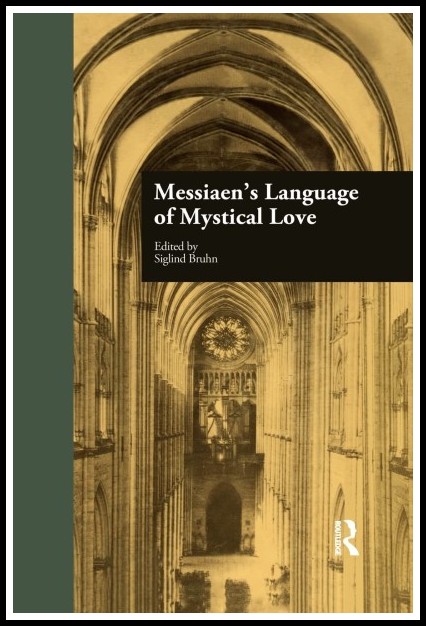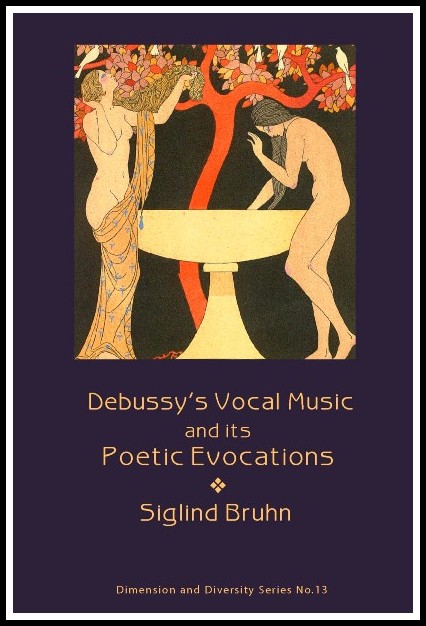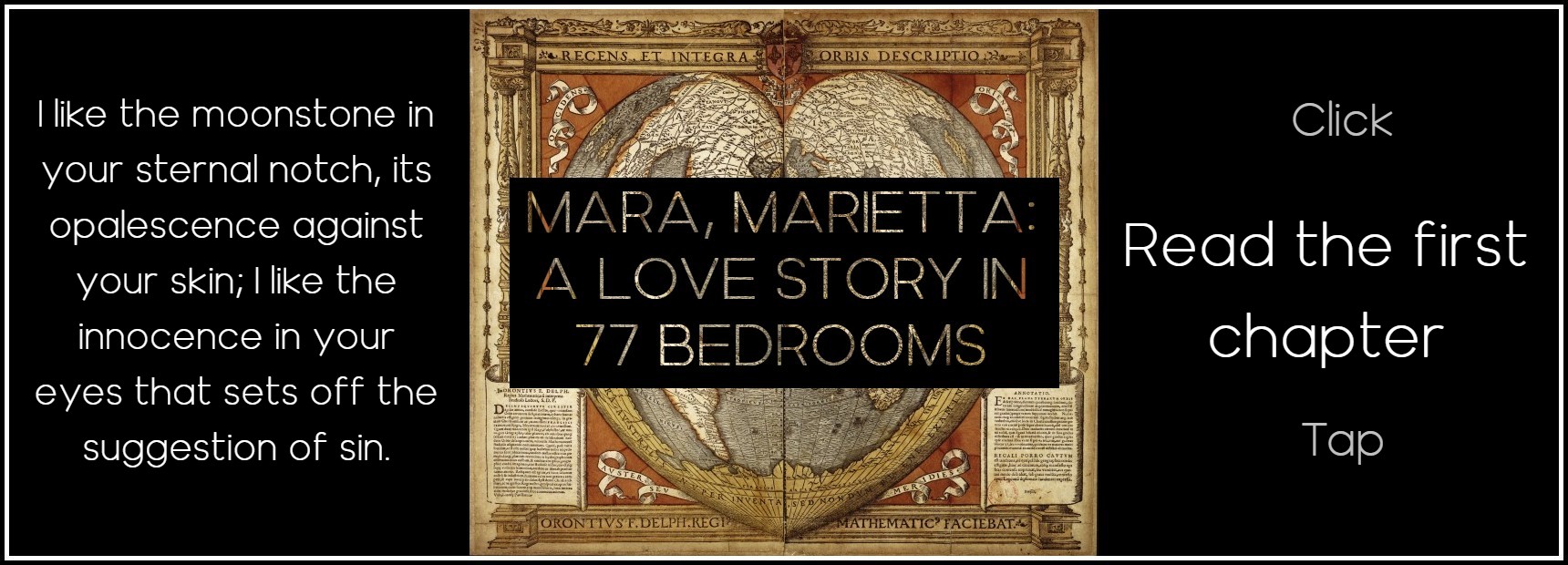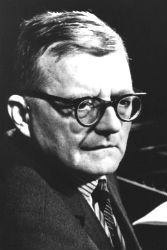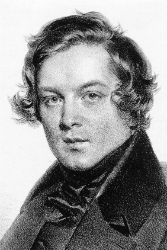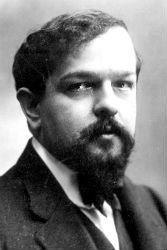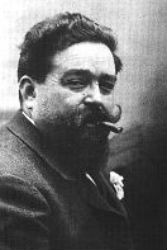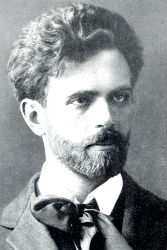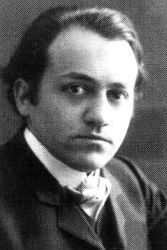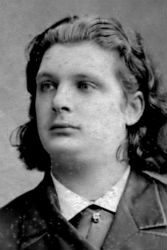DEBUSSY
Preludes, Books I & II | Canope

PART I: DEBUSSY – PRELUDES I & II: INTRODUCTION BY SIGLIND BRUHN | PART II: ANALYSIS & PERFORMANCE (+ SIGLIND BRUHN ON ‘CANOPE’ & ‘CANOPE’ IN ‘MARA, MARIETTA’)
DEBUSSY: PRELUDES – BOOKS I & II
PART I – INTRODUCTION BY SIGLIND BRUHN
Posted by kind permission of Siglind Bruhn, musicologist, concert pianist & interdisciplinary scholar
From Siglund Bruhn, Images and Ideas in Modern French Piano Music: The Extra-musical Subtext in Piano Works by Ravel, Debussy, Messiaen (NY: Pendragon Press, 1997) pp. xxiii-xxvi
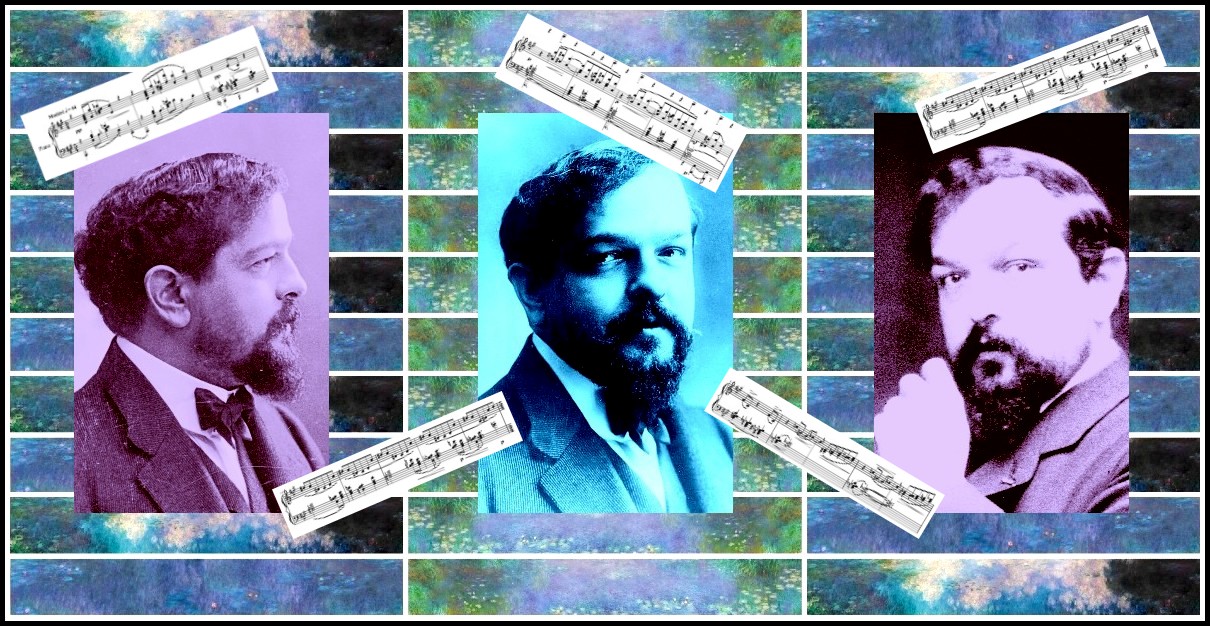
Claude Debussy, Préludes | Claude Monet, Nymphéas
Debussy’s twenty-tour Preludes, written between 1909 and 1913, constitute a summit of piano composition comparable to the large piano cycles of the Romantic era. What makes this work so outstanding is not only the superbly varied array of sound colors and other depicting devices, but also the impressive wealth of musical thoughts, each of them unique within both the cycle and Debussy’s entire compositional output.
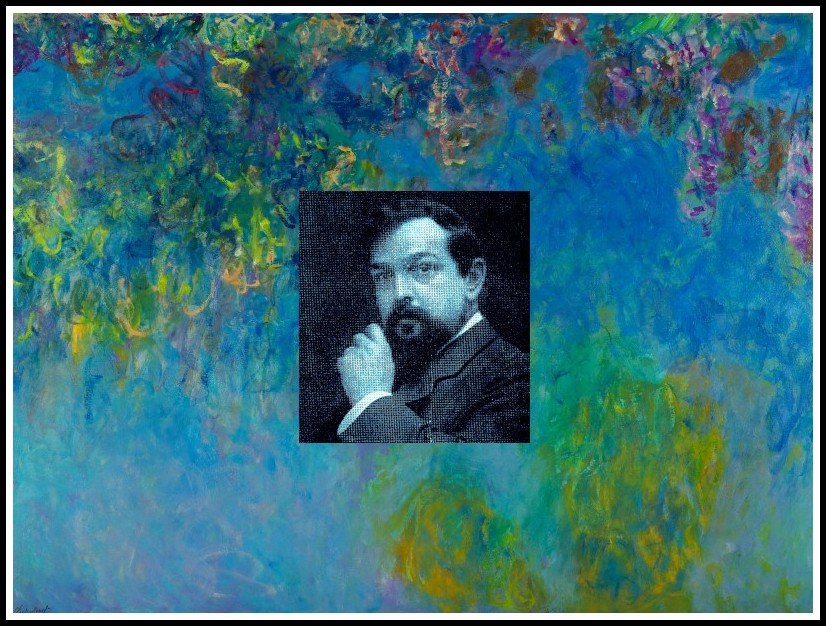
Claude Monet, Wisteria, 1925 | Claude Debussy, Bibliothèque nationale de France (BnF)
The Preludes present us not so much with a chain of pieces linked in content and demanding to be rendered in the order in which they appear, but rather with a collection of single pieces of very different origin and character. The composer, typically critical of his own creations, remarked that they weren’t all equally good—a judgment that has survived to this day, especially among those who don’t know the Preludes too well. This is one more reason to consider the cycle in its entirety and to juxtapose, in study as well as in performance, well-established pieces with little-known ones.
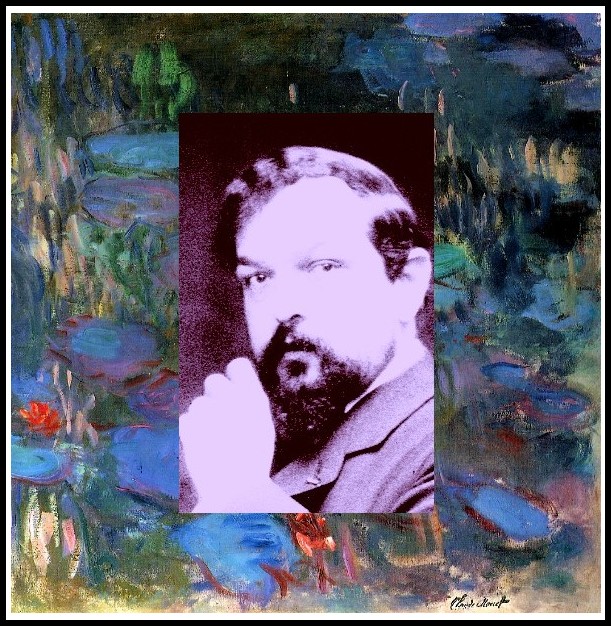
Claude Monet, Waterlilies | Claude Debussy, BnF
The number of pieces, twenty-four, picks up a tradition that originated with 18th-century composers’ joy of being able to write pieces on all major and minor keys for the ‘well-tempered clavier.’ From the two volumes of J. S. Bach’s preludes of 1722 and 1744, each of twenty-four, the incentive remains the same with those who followed (Johann Nepomuk Hummel, Chopin, Alkan, Stephen Heller, Busoni, Scriabin, César Cui). Debussy followed this example, yet without linking his design to the idea of twenty-four different keys in any particular order. What distinguishes his cycle significantly from its forerunners is the fact that he chose poetic titles. Here again, Debussy looked back on a tradition in his own country: the close relationship between, and mutual influence of, music and words. One could speak of the literary character of French music in general. Machaut, Janequin, Couperin, Rameau, Berlioz, Boulez wrote their own texts, employed descriptive titles, or wrote extensively about music.
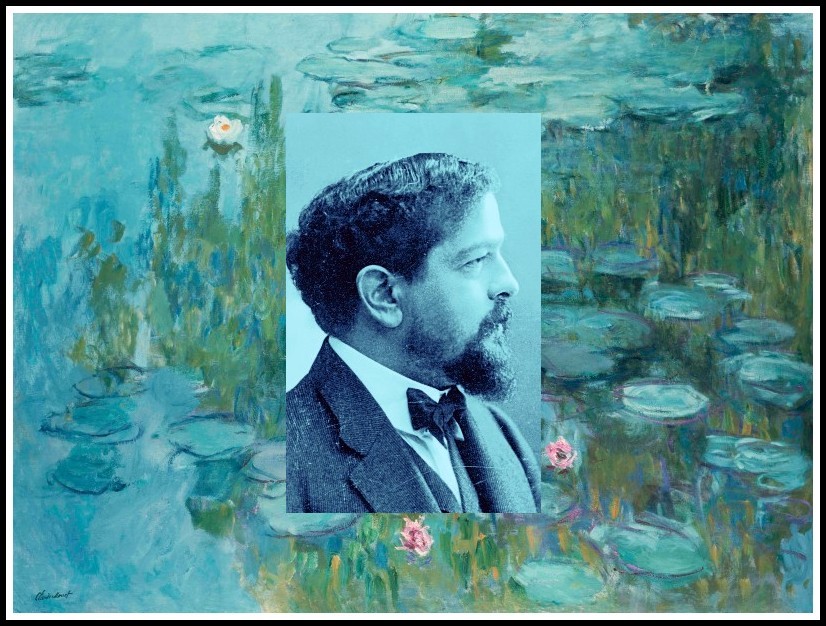
Claude Monet, Water Lilies | Claude Debussy, BnF
In the Paris of the late nineteenth and early twentieth centuries, composers found an atmosphere of artistic ferment, nourished primarily by the literary figures of the circle that met regularly at such places as the Chat Noir. As Paul Dukas recounts, ‘Verlaine, Mallarmé, Laforgue brought us new tones, new sounds. They projected heretofore unseen lights onto the words, they used methods unknown to their predecessors, and they allowed the verbal substance to produce effects of a subtlety or power that one would not have thought possible. Above all, they conceived their verses or their prose like musicians’. Debussy became involved in a number of literary circles, particularly at the Librairie de l’Art Indépendant, at the Taverne Weber, which he frequented together with his close friend Pierre Louys, and at the ‘Tuesdays’ at Mallarmé’s house. A quotation from the composer gives a good idea of his conception of the relationship between music and word: ‘l conceive a different dramatic power—a music that begins where the expressive power of the word ends’.
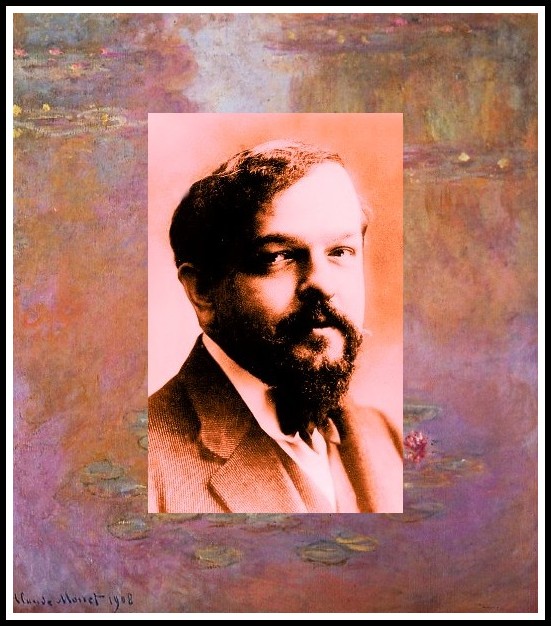
Claude Monet, Water Lilies | Claude Debussy, BnF
Debussy’s oeuvre for solo piano contains a large number of miniatures accompanied by evocative words, lines, or epigraphs. These verbal allusions never precede the music but invariably appear beneath the final measures of the score. This has led to suggestions that they may not be intended to guide the imagination. It has even been held that performers and listeners would actually appreciate the music for its absolute value just as much without having in mind the allusion given in the caption.
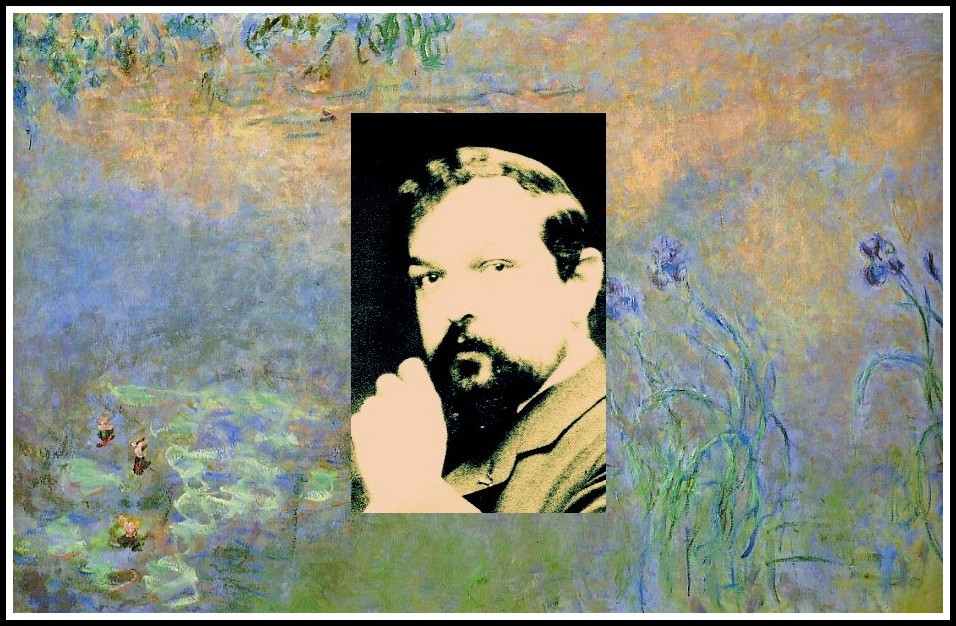
Claude Monet, Water Lilies | Claude Debussy, BnF
While Debussy’s music provides a complete aesthetic experience even when perceived without any extramusical stimuli, there is much more to the composer’s explanatory after-titles than meets the eye. Careful investigations into the metaphors and material components, semantics and structure, attitude and perspectives adopted in both the non-musical source alluded to and in the musical miniature alluding to it reveal highly complex relationships. One can thus read the results of the musical analysis as Debussy’s interpretation and creative re-enlivening of a poet’s or artist’s imagery, or—in a few cases—of that expressed in nature. This adds a vital perspective to our appreciation of the ‘absolute’ music, affecting both our performance and our listening attitude.
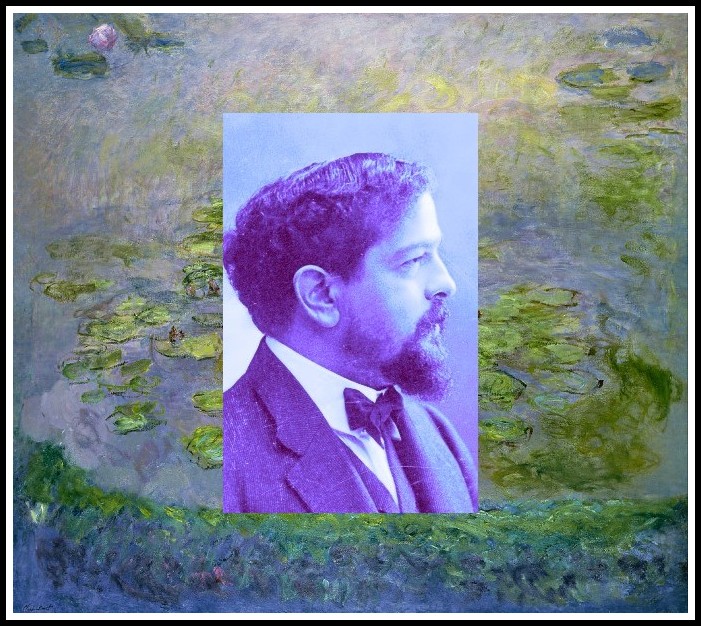
Claude Monet, Water Lilies | Claude Debussy, BnF
DEBUSSY: PRELUDES – BOOKS I & II
PART II – HARRY HALBREICH: ANALYSIS | E. R. SCHMITZ: PERFORMANCE
Harry Halbreich text translated from the French by Richard Jonathan
Harry Halbreich (1931-2016) was a musicologist and a contributor to the promotion of modern and contemporary music. The following text is my translation from the French of Edward Lockspeiser & Harry Halbreich, Claude Debussy (Paris: Fayard, 1980) pages 579-593. I have edited the text for the sake of concision.
E. Robert Schmitz (1889-1949) was a renowned concert pianist and the leading interpreter of Debussy in his day. Given in gold typeface below, his notes on the interpretation and performance of the Préludes are taken from his book, The Piano Works of Claude Debussy (Dover Publications, 1950/1966).
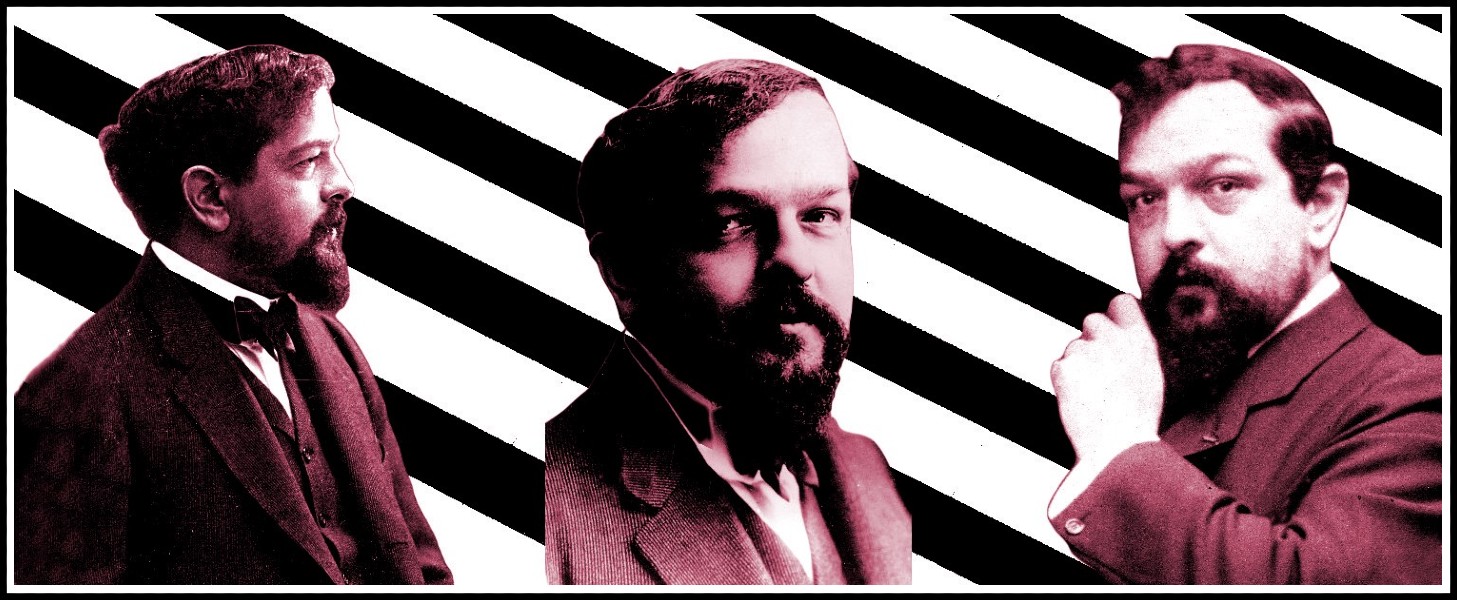
Claude Debussy
DEBUSSY – PRELUDES – BOOK I
1. DANSEUSES DE DELPHES
This slow sarabande (lent et grave, doux et soutenu, B-flat major, 3/4), with its studied harmonies, is firmly anchored in the principal tonality of B flat, and its tonal functions all remain standard. The tonal quietude, the evenness of the rhythm, accentuate the hieratic quality of the piece, inspired by a sculptural fragment, which Debussy had seen at the Louvre, depicting a group of three dancers at the temple at Delphi The composer’s associate, pianist Marguerite Long, had this to say: ‘Debussy played this piece slowly, with an almost metronomic exactitude. His sound was soft and densely hieratic, making the sculptured figures more priestesses than dancers, with the last two chords evoking prostration.’
PERFORMANCE (E. Robert Schmitz, The Piano Works of Claude Debussy, pp. 132-33)
The very nature of the three levels of musical development in this piece gives the basic clue to its interpretation: the melody softly sustained and expressive, capable of rhythmic developments; the frame chords gently detached, impersonal, opposed in effect to the expressive melody, and also the third, incisive interpretation of the metallic crotals, which must carry a resonant tone, ringing with multiple harmonies, vibrating in ever-larger circles around their fundamental tones (measures 8-9 and 16-17). Soft pedal (bars 1-2). To emphasize the melody (B, B, C, C), we suggest abducting the arm, thus lifting the chord, but keeping the melody note depressed. The pedal will maintain the total effect of the three planes: bass, melody, and harmony. (Difference in dynamism, PP and P for the melody). Note that the melody obtains a crescendo which follows the pitch ascent in each of the two first measures. While this crescendo continues to the completion of the melody in the fourth measure, the third measure also takes into consideration accents on the longer note values. This interpretation holds good to measure 11, where pitch is given preference over duration, and brings accents on the last sixteenth-note of each beat. In the seventh measure from the end, the accents are on the second and third beats, with the chord on the sixteenth-note continuing the crescendo between these strong beats. The last eighth-note of the measure in the right hand, the chord, is light, but the left hand slurred to the first beat of the next measure receives a contradictory accent. In the pedaling, one must change pedals sufficiently fast and often to avoid catching the frame-chords, particularly in passages such as that beginning eleven measures from the end, in which the pedal is changed each half-beat. Conversely, the crotal chords must be given full chance along with the melody to ring freely for the full note value, but not beyond, for this would result in a blurring of many sounds.
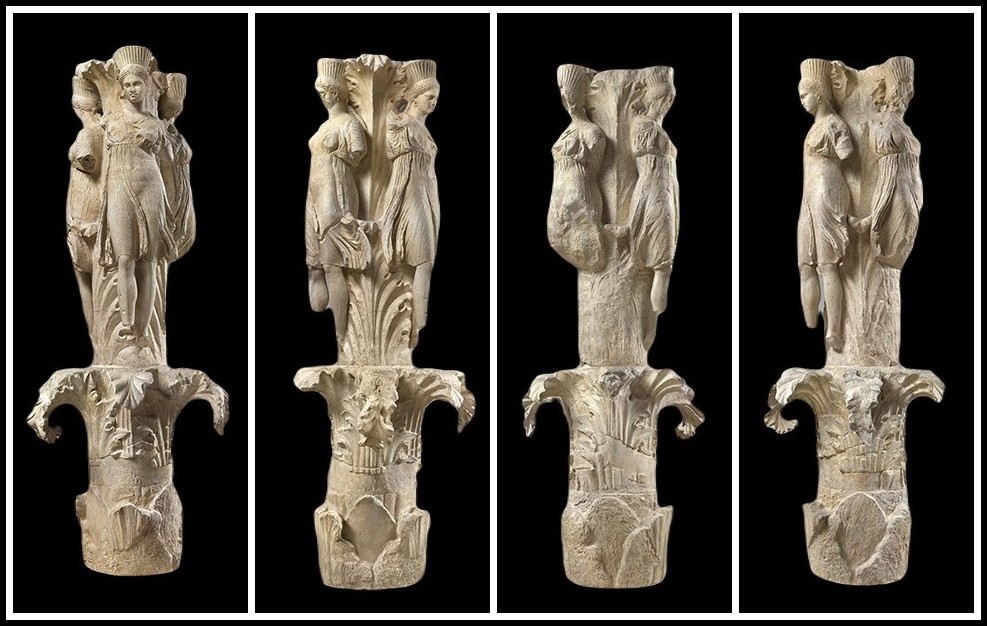
Column of Dancers at Delphi | On display at the Louvre from 1901
2. VOILES
‘Voiles’ (modéré, C-major, 2/4) may be a serene evocation of an evening at the seaside, white sailboats gliding on calm water, but Debussy warns us against naturalism: ‘It’s not a photo of a beach, a summer holiday postcard’. The seashore is silent and deserted, and the rather hesitant clarity of the music has a veiled quality (‘veil’ being the other meaning of voile, ‘sail’). This is due to the constant use of whole-tone scales, from which emerge all the more clearly the bright spot of color of the four-bar pentatonic interlude on the black keys, which saves the piece from the sterility inherent in this scale.
PERFORMANCE (Robert Schmitz, The Piano Works of Claude Debussy, pp. 135-36)
In performance, note that the quality of touch and pedaling must take into account the three distinct levels upon which the whole is built. These levels have individual personalities and capacities when first stated, and retain these characteristics when superimposed upon each other. In order of relative importance the three levels are: the melody, the ostinato, and the pedals, the pedals least since their expressive possibilities are the least developed. Besides the diversity to be sought in the interpretation of the three levels contrasted to each other, within the first two levels one must also obtain an apt differentiation in dynamics for the points of tension and those of release, and a pedaling which does not mix appoggiaturas with their resolutions.
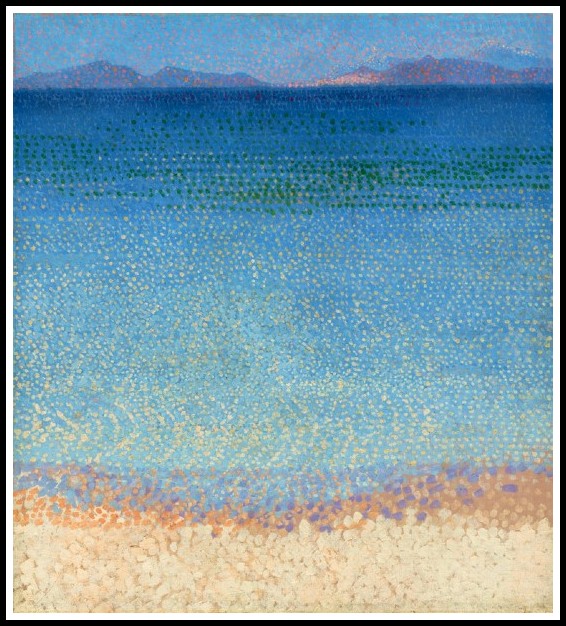
Henri-Edmond Cross, Les Îles d’Or, 1892
3. LE VENT DANS LA PLAINE
A wind from who knows where (animé, aussi légèrement que possible, E-flat minor, 4/4), furtive and rather mysterious, marks out the trembling of long grass, figured by a continuous background of arpeggios. The piece, whose color is determined mostly by the minor second interval and by the parallel sevenths, remains suspended to the end around the dominant of the prinicpal tone, but at its exact center, it culminates in six violent chords in the relative key of G-flat major.
PERFORMANCE (E. Robert Schmitz, The Piano Works of Claude Debussy, pp. 138-39)
Do not melt together the sounds of the opening trill, of which various forms are used nearly throughout the prélude. These figures must be very light but with each note distinct. A very superficial forte pedal may be used or none at all. This is particularly true of the first and fourth lines of the opening page. The B pedal should be prepared with the sustaining pedal. The rest in the third measure must be observed, and the 32nd-notes must not become 16ths. Gently detach the chords (measures 9-12, and in recapitulation later); in this passage the pedal should be changed according to the movement in the bass. The outbursts must receive the full impact of the forte marked for them, but the immediate resumption of piano and pianissimo must not be missed. No pedal under the chromatic passages (measures 39-40, 43-44). Do not fail to hold the chords forming the chromatic cadential progression (measures 55-60), for the voice-leading from chord to chord is of utmost importance to the final effect of the last B.

Daniel Urbanik, The Wind in the Grass
4. LES SONS ET LES PARFUMS TOURNENT DANS L’AIR DU SOIR
In Les sons et les parfums tournent dans l’air du soir (inspired by Baudelaire’s ‘Harmonie du soir’), with that strangely-colored harmonic phrase running through it like an ostinato, one breathes a heady, voluptuous atmosphere. The harmonic alchemy, despite the well-established and rarely-challenged major tonality, attains great refinement. From the initial melodic series (E, A, B-flat, F-sharp, C-sharp) one can deduce all the non-chord tones and harmonic combinations. Indeed in terms of harmony, it is one of Debussy’s most advanced pieces, thanks to its seriality and the role played by melodic intervals in the structure. It unfolds according to the rhythm of a ‘very slow imaginary waltz’, which now and then interpolates a 2/4 into the 3/4 measure, which produces a 5/4 (echoing Baudelaire’s line ‘valse mélancolique et langoureux vertige’ from ‘Harmonie du soir’).
PERFORMANCE (E. Robert Schmitz, The Piano Works of Claude Debussy, pp. 141-42)
One of the first notions which must permeate this prélude is that its interpretation must not seek after obvious effect, or more precisely, that its accents, crescendi, decrescendi must fit within the opening admonition of ‘harmonious and supple’ and will not allow angular or baroque dynamic effects. Yet a considerable richness of rhythm of the superimposed levels must be respected. For instance, observe that the A pedal, in the first few measures, displaces itself from the first beat to the second, third, second, third, etc. Note that in the second and third measures, and in those only, it forms an acute dissonance with the middle voices. Remark that the melodic accents reach a climax on the third beat of the first two measures (in 5/4 time), then on the third beat of measure 3, the second beat of measures 5 and 7. The first beat of measure 9 carries weight in the lower and middle register and in the upper register the third beat is climaxed. In measure 10, the lower register reaches its accent on the second beat and the upper voices on the third. All these differentiations of dynamics and rhythm must be clearly present, despite the subdued level of the entire piece, of which the majority is PP, and which never reaches beyond a MF, and this only for short periods. Another important point is keeping the continuity of the middle voice in the twenty-three opening measures and in succeeding fragments. For instance, the E natural in measure 8 (dotted half-note) must lead to the E of the following measure in the same voice level. Another instance: the chord at the beginning of measure 13 leads to that in measure 14, and to that in measure 15, and also to those in measure 18, a feat for which the pedal will have to be largely responsible. The three ‘rubato’ passages in the second page of the prélude are to be considered as hesitating on the first two notes (long values), and precipitating the arpeggio which succeeds them. A more crystalline touch must be reserved for these outbursts, and also (but softly) for the horn call at the end.
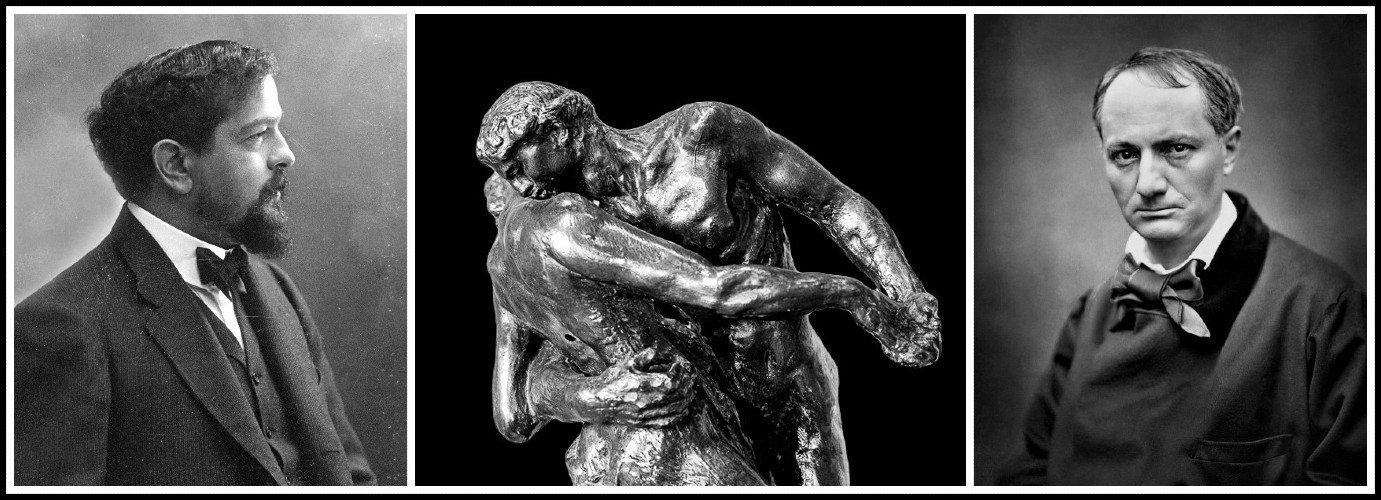
Claude Debussy | Camille Claudel, La Valse, 1893 | Charles Baudelaire
5. LES COLLINES D’ANACAPRI
Debussy’s only Italian-inspired piano piece is this lively and luminous prelude (vif, B major, 12/16, 2/4), cleanly written, featuring staccati of typical Mediterranean dryness. It evokes thyme, rockrose, the scent of the maquis. Debussyan pianists Alfred Cortot and Marguerite Long remark: ‘Under the vibrations of a deep blue sky pierced by the swift notes of a flute, a network of tarantellas hems in the Gulf of Naples with its villas and caves; when the boisterous dancers pause, a languid peasant song conjures up all the tenderness and audacity of a Neapolitan ragazzo’. Strictly monotonal, never straying from the tonality of B-major, the spherical fixity of the harmony makes a striking contrast with the refinement of the preceding prelude: the spotless blue of the Neapolitan sky admits neither nuances nor harmonic chiaroscuro.
PERFORMANCE (E. Robert Schmitz, The Piano Works of Claude Debussy, pp. 144-45)
In the introduction a resonant tone, not harsh or loud but long in its vibrations, must be used for the bell tones, held by the pedal. In contrast, though still light, the motifs from the tarantella can already be sharper, gaining dynamically the second time. The tarantella must be light and fleet, the lower voice should not be burdened by metric accents. In the minor passage, note that this material is much more expressive and must be phrased very carefully, particularly from the end of measure 26 to 28. Note the dynamic markings and phrasing by three notes. Observe that a certain amount of freedom is allowed in the performance of the second theme (‘Cédez’). This popular material is nostalgic, romantic, but it is easy to overdo. The slight lengthening is best felt at the end of the questioning first phrase, to which the answer (second phrase) must reaffirm strict timing. In the third material (measures 49-65) the quarter-notes must be held by the fingers in order to carry their resonance, for the pedal will be changed with the evolving melodic line. The grace notes should not be clipped, but played with the left-hand chord and resolved at ease, so as to melt into the languid nature of the middle-voiced melody. Note that the A natural (measures 63 and 65) must be heard somewhat above the bell motif and linked to the softer resolution on B. Do not shy away from the unparalleled brilliancy of the last few measures to the prélude: FFF; it is the natural crowning of the joyous exuberance of the dance, of the landscape, of the glaring, blatant sun.
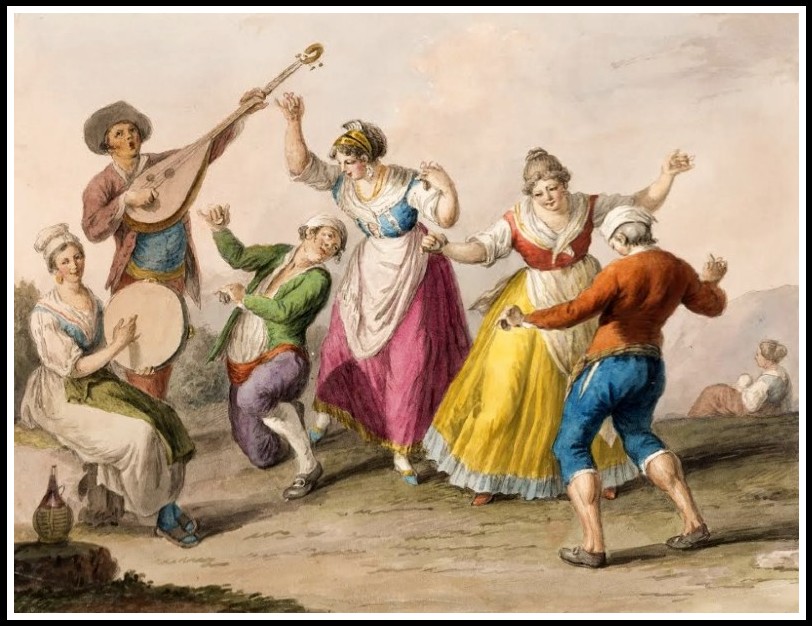
Saverio della Gatta, Tarantella Dancers, 1828
6. DES PAS SUR LA NEIGE
Right after composing ‘Les collines d’Anacapri’, that vision of sunshine and joy, Debussy wrote ‘Des pas sur la neige’, thirty-six measures of silence imbued with solitude. He has suddenly transported us far from human presence, far from all life, to this deserted countryside where a faceless being has left a fragile trace of his—or rather her—passage, a trace the north wind will soon efface. Debussy specifies that the rhythm of the piece must be ‘the aural equivalent of a backwoods sad and frozen’. Against this twilight ground rises a lament in the D minor pentatonic scale (triste et lent, D minor, 4/4). In contrast to the principal tonality, a second idea, barely hinted at, touches on G-flat major. ‘Like a sad and tender regret’, the composer indicates at its fleeting recurrence, confirming that the piece is about the embodiment, already pale and elusive, of she who was passing this way. Slowly the vision fades into a fog: with very few notes, Debussy has expressed ineffable emotion.
PERFORMANCE (E. Robert Schmitz, The Piano Works of Claude Debussy, pp. 146-47)
The melodic line, delicately woven as it is, still bears the burden of the emotional message of this piece, and sensitive attention must be given its note-values and pitch line to render truthfully its despairing loneliness. Note that the two important emotional climaxes are at measures 23 and 30, and are built by ascending whole-toned series, receding in descending minor thirds, effectively slurred by two’s, in the sob-sigh of renunciation. Yet even these climaxes (particularly A-flat in measure 23, and C-flat in measure 30) are played P, and should not be overreached dynamically. They are the apexes of the piece which starts with PP and ends with PPP. The entire palette of dynamics must be contained within the restrained gamut from P to PPP, with the classical design of the curve reaching its greatest intensity through two-thirds of the piece, and receding again. From measure 29 on, ‘Comme un tendre et triste regret’, observe the long ascent of three lower voices in parallel 6/4 position, reaching its climax on the last beat of measure 31, after crossing over the decreasing upper melodic line. Do not interrupt either of these crossing lines, since they are continuous as to interpretation, and independent as to dynamics. It must be noted that this independence of dynamics is of the very nature of this piece, conceived at several independent levels, and in which the melody is marked repeatedly by Debussy, as being a shade louder than the ostinato. The pedaling must be extremely careful so that overlapping of sounds does not break the bleak purity of this small landscape. Change the pedal immediately at the resolution of the appoggiatura in the ostinato. A soft pedal should be kept throughout the piece.
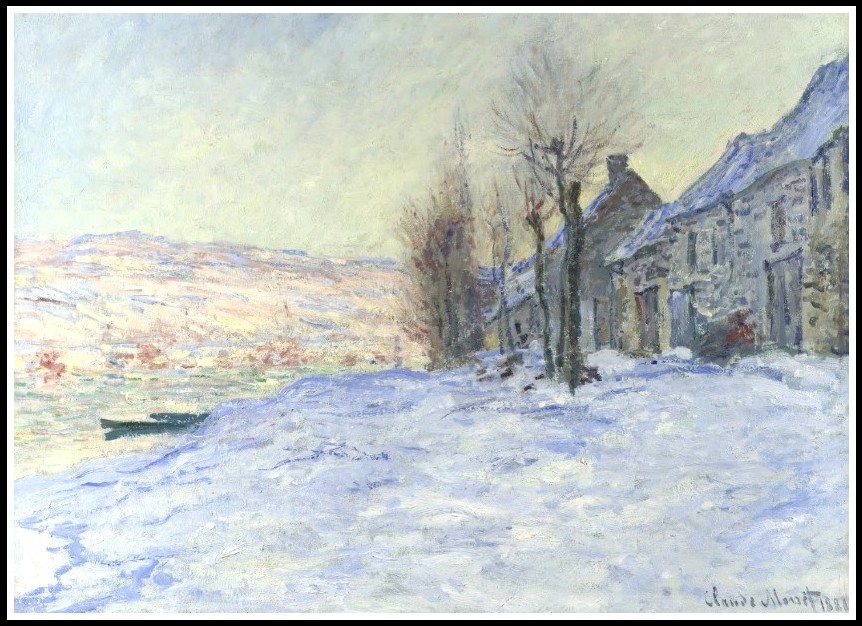
Claude Monet, Lavacourt Under Snow, 1880
7. CE QU’A VU LE VENT D’OUEST
Even more than the orchestral triptych La Mer, this wind from the west—blowing in from the high seas, gusts raging under a leaden sky—evokes the ocean. Chromatic hurricanes rumble with a violent passion too often denied the great romantic that Debussy, when he wanted to, could be. The swirling sea, waves raging on the verge of breaking, the backwash—each are evoked by a prodigiously rich pianistic writing, right up until the ferociously dissonant chord, violent and cleanly struck, that abruptly ends the piece. Already for the eye, the score evokes an almost Lisztian brilliance and violence. The dissonant nightmare begins in the piano’s low register, and with the exception of a few incursions of the bass towards D-sharp and B, the entire piece unfolds on tonic pedals, rarely leaving the principal tone of F-sharp minor. The strongest harmonic tensions here are based on the tritone interval F-sharp—C. Due to its harshness and brutality, to the asperity of its eruptive and chaotic parallel seconds, this prelude represents one extreme in Debussy’s oeuvre. The prelude that follows—calm, euphonic, serene—lies at the diametrically opposite pole.
PERFORMANCE (E. Robert Schmitz, The Piano Works of Claude Debussy, pp. 149)
Note the extremes of dynamics used in this composition. They must not be underrated in performance. As a general principle the heavily scored chords are dynamically more important than the atmospheric arabesques in single notes (usually of shorter durations than the chords); when the two co-exist, which is frequently the case, plan a different dynamic terrace for each. Note also the persistent markings of Debussy indicating crescendi and decrescendi respectively on ascending and descending pitch levels. This insistence is here of spectacular effect in view of the nature of the work. At the beginning of the piece, the F pedal is to be prepared with the sustaining pedal in advance, i.e., depressed silently and caught with the pedal in advance, so that its resonance may be kept as desired and yet leave the forte pedal free to do justice to the other voices. In the passage beginning measure 15, the short durations in the bass are to be percussive. In the passage beginning at measure 25, keep the melodic fragments at different levels from the trill, not blurred into it.
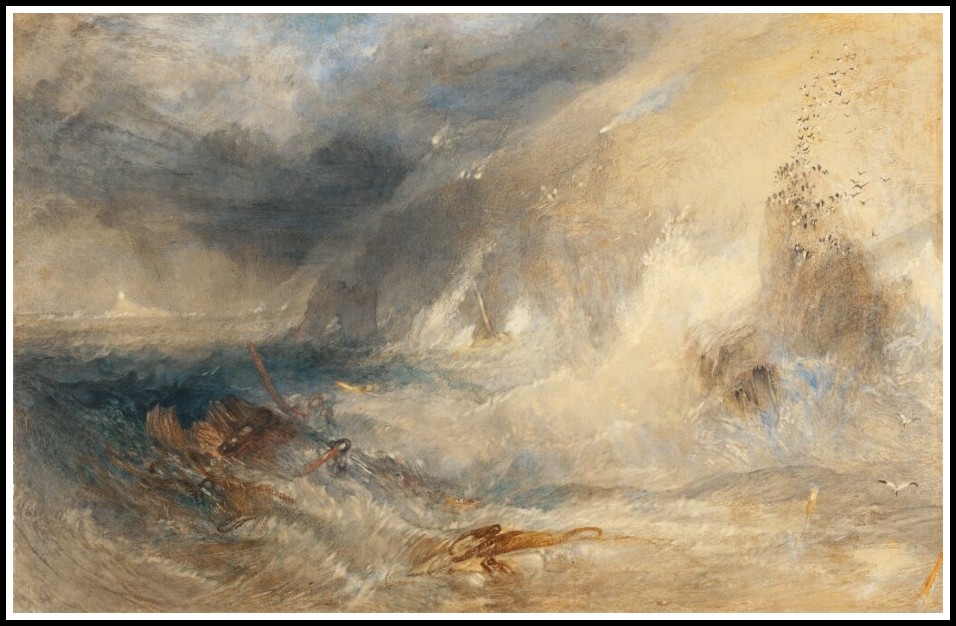
J.M.W. Turner, Longships Lighthouse, Land’s End, 1835
8. LA FILLE AUX CHEVEUX DE LIN
A long modal melody, calm and gentle, evokes this placid sister of Mélisande, which, given the predominance of the pentatonic scale, we may consider Celtic in origin. We find here one of Debussy’s strongest musical atavisms, which we also find in ‘Bruyères’: here as there, the piece consists in one big melodic arabesque.
PERFORMANCE (E. Robert Schmitz, The Piano Works of Claude Debussy, pp. 152)
It will be noticed that the dynamic strong points are throughout placed at the apex of the melodic line and are often coincident with harmonic stresses (suspensions or appoggiaturas) and with durational weight, i.e., long values. This brings a rather simple scheme of accents but one which forms the entire basis of the interpretation of this piece, and therefore must be given close and steady attention. In the 16th measure, anticipate the grace note somewhat, so that there will be no break in reaching the right-hand apex on the first beat. In measures 22 and 23, observe the accents both times on the fourth eighth-note of the measure, a very charming syncopation in the otherwise fairly metric scheme of this prelude.
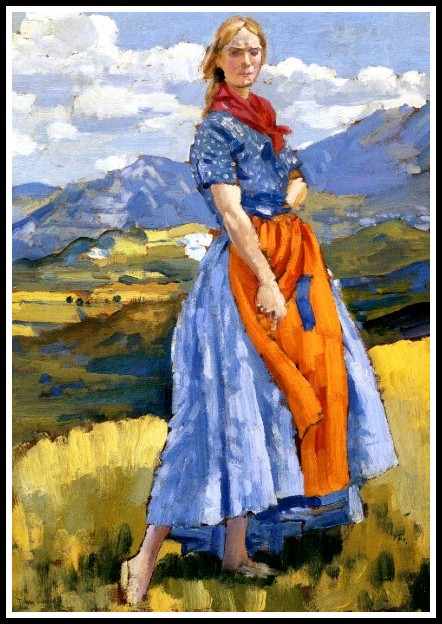
Augustus John, Lily at Tan-y-grisiau (The Orange Apron), 1913
9. LA SÉRÉNADE INTERROMPUE
With its 3/8 measures evoking the jota, its staccato rhythms, its principal tonality of B-flat minor and the modal harmonies that derive from it, ‘La Sérénade interrompue’ comes across as a clearly guitar-influenced piece. A masterly satire of Spanish lovers, it is nervous, sarcastic, fantastical, a veritable musical equivalent of a Goya Capricho. Alfred Cortot: ‘Myriad street incidents interrupt our pitiful Don Juan’s love song.’ Vladimir Jankélévitch: ‘The same guitar prelude started and restarted twenty times, the same furious, pitiless improvisation wrings the neck of the incipient serenade and finally imposes its tonality of B-flat minor.’ Manuel de Falla, however, has a slightly different interpretation: ‘Two serenaders are fighting for the favors of a lady who, hidden behind the flower-adorned lattice of her window railing, observes the gallant contestants’. Whatever the case may be, we are dealing here with one of Debussy’s most Spanish pieces: the range of the piano, reduced to three octaves, is that of the guitar, and the Gypsy scale opens out at times into free melismas, like the ones Ravel wrote in his Alborada del Gracioso. The form of the movement is strictly ternary—which takes the cake for such a discontinuous piece. Twice, the intervention of a completely foreign element creates a strange sensation of spatial distancing: a citation from Ibéria, the irruption of ‘Le Matin d’un jour de fête’ into the torpor of ‘Les Parfums de la nuit’.
PERFORMANCE (E. Robert Schmitz, The Piano Works of Claude Debussy, pp. 154-55)
Observe that much of the mocking charm of this prélude comes from the abrupt nature of the interruptions and that clear levels of differences in the interpretation and dynamics must parallel the differentiated musical textures. The dryness and brittleness of the guitar effects are destroyed by the use of the pedal. Its use should be extremely limited nearly throughout the prélude, with only fragments of the second material pedaled, still sparingly. Further, the opening section demands a rapid and light staccato touch, with active, articulated fingers, which must be contrasted in the second theme by a lyric, legato, singing tone. Note that the underlying rhythm of the third material (pedal chord) is light on the first beat and accented on the second, a limping or inebriated gait, which is all too often ignored by performers. Soft as the ending is, the staccato quality must still be preserved in the last few lines, and at the cadence, subdued but exact.
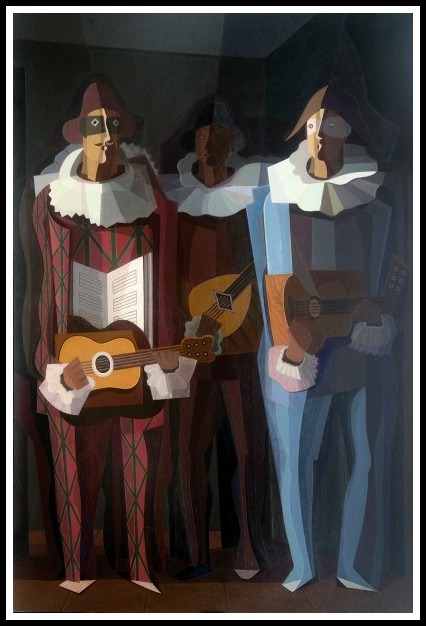
Emilio Pettoruti, The Last Serenade, 1937
10. LA CATHÉDRALE ENGLOUTIE
‘La cathédrale engloutie’ arises from the old Breton legend of the town of Ys, once engulfed by the waves and now revealing, at low tide, the foundations of its cathedral. It is the most fully developed prelude in Book I, and the most powerful. Its pianistic writing, with its great blocks of chords stacked over seven octaves, is truly monumental. The entire piece is based on the fundamental cell C-D-G, which sometimes stretches to C-D-A. This very medieval conception makes great use of plainsong modes, and in particular of 12th century organum intervals (fourths and fifths). The first section (profondément calme, G major as the dominant of the principal tone C major, 6/4—3/2) begins ‘in a softly sonorous fog’ and continues ‘gentle and fluid’. It evokes the calm water from which will emerge, in the second section, the chimes of unreal bells, ‘gradually emanating from the fog’. The third section, the first peak of intensity, has us hear the organ of the old cathedral in archaic perfect chord progressions, as in an old chorale. A meditation, ‘expressive and concentrated, gathering strength as it progresses’, over a dominant pedal in C-sharp minor, rises to a second peak of intensity, and, at its end, via a ‘wavering and muted’ sequence we hear, like an echo, the organ in the murky water. In the brief conclusion, the cathedral disappears beneath the waves again. Philosopher and musicologist Vladimir Jankélévitch recognizes in this piece the supreme expression of disaggregation: ‘It is a reflection in water, a reflection of something buried in the depths; it is a trembling, deliquescent architecture.’ I would add that it is also the reflection of something buried in the past, and that this past telescopes into the present in a radically new way, testifying to Debussy’s tenacious desire to embrace time in order to abolish its flow.
PERFORMANCE (E. Robert Schmitz, The Piano Works of Claude Debussy, pp. 158)
The performance of this prélude must immediately take into consideration the differentiation of levels and touch to be applied to the bells (resonant, slap touch); to the melodies a series of legato arches of which all the voices must be closely integrated as to dynamics and timing (no single voice standing out, or effects of broken chords by dint of an unequal depression of the entire chord), and which must, except in measures 14 and 15, have a singing quality following their melodic line to the moving pedals, the least dynamic material, subdued but constant. One must also envisage the necessity in pedaling, touch and length of motions, weight, of minute variations of these, from the misty calm of the opening, through the gradual emergence of the Cathedral, to the sonorous apex of its victory over the sea, and the receding, engulfing process of the last sections. A further study of pedaling (of the sustaining pedal) is necessitated by the frequent pedal-points.
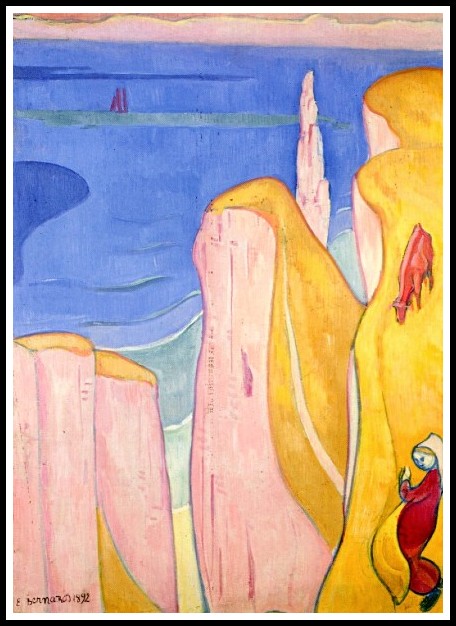
Émile Bernard, Les Falaises d’Yport, 1892
11. LA DANSE DE PUCK
‘La Danse de Puck’ (E-flat major, 2/4), with its refined, occasionally bitonal, harmonies, offers a charming musical portrait of Shakespeare’s mischievous sprite immortalized in A Midsummer Night’s Dream. A will-o’-the-wisp, Puck flares up, leaps about, whirls around before vanishing into the air. The freedom of the musical discourse, the fluidity of the rhythms, the unexpected harmonic pirouettes—all this apparent diversity conceals a profound unity, due as much to the ternary form hidden beneath the piece’s succession of eight sections as to the secret links woven by the homogeneous intervals. The tonal center, E-flat, remains implicit, never settled on, constantly demolished by the D-flat (or C-sharp). Fortunately, the diatonic theme of Oberon’s horn re-establishes the balance from time to time.
PERFORMANCE (E. Robert Schmitz, The Piano Works of Claude Debussy, pp. 159-160)
A patent mishap occurs nine out of ten times in the interpretation of this prélude. The dotted rhythm of the opening and other large sections of the piece is interpreted as if the thirty-second-note was linked to the succeeding dotted sixteenth-note, whereas Debussy has carefully marked the slur as going from the dotted sixteenth-note to the thirty-second. The effect is very different, and redressing this one aspect of interpretation is of considerable importance. The motif (measure 6 and later) will be found to have the value of a muted brass, i.e., more pungent than the dotted material. Observe, in measures 24-27, that the appoggiaturas are accented, the resolutions lifted. The third material softly legato, a definite contrast to the opening material, must yet be dynamically above the accompaniment in seconds.
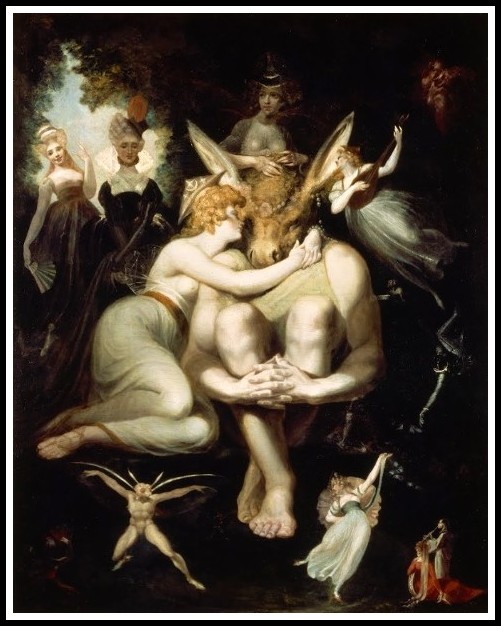
Henry Fuseli, Titania, Bottom and the Fairies, 1794
12. MINSTRELS
‘Minstrels’ (modéré, nerveux et avec humour, G major, 2/4) is a quick sketch, at once graceful, derisive and cheerful, which reveals a very English strand in Debussy’s sense of humour. One can see it as the first example of a form of musical grotesque that, after WWI, would inspire Stravinsky (Histoire du Soldat, Ragtime), Hindemith (Ragtime on a theme of J.S. Bach) and many others.
PERFORMANCE (E. Robert Schmitz, The Piano Works of Claude Debussy, pp. 161-62)
In the performance of this prélude, one notes first that the ornaments of the first section are to be played on the beat and must not mix with, nor detract from, the solid though staccato notes in larger type. Measures 9-10, and similar passages, are marked very detached and should be very strict, whereas the succeeding four measures allow for a certain amount of legato and rubato. Observe that precision and sharpness must reassert themselves from the end of measure 14. Note the slurring in measures 28-31, essential to the syncopated gait. The bad-joke episode, sarcastic in nature, allows for some rubato, to which a quick recovery of precision must succeed at the end of the episode. In the drum episode, note the accents on the seconds. The triplets are light but converge to these accents. Freedom is again in order for the sentimental song, but, at the tempo primo of the last page, strictness must be maintained, and in the acceleration (‘plus allant-serrez’) of the last few bars, the notes beat a clipped tattoo in rapid succession.
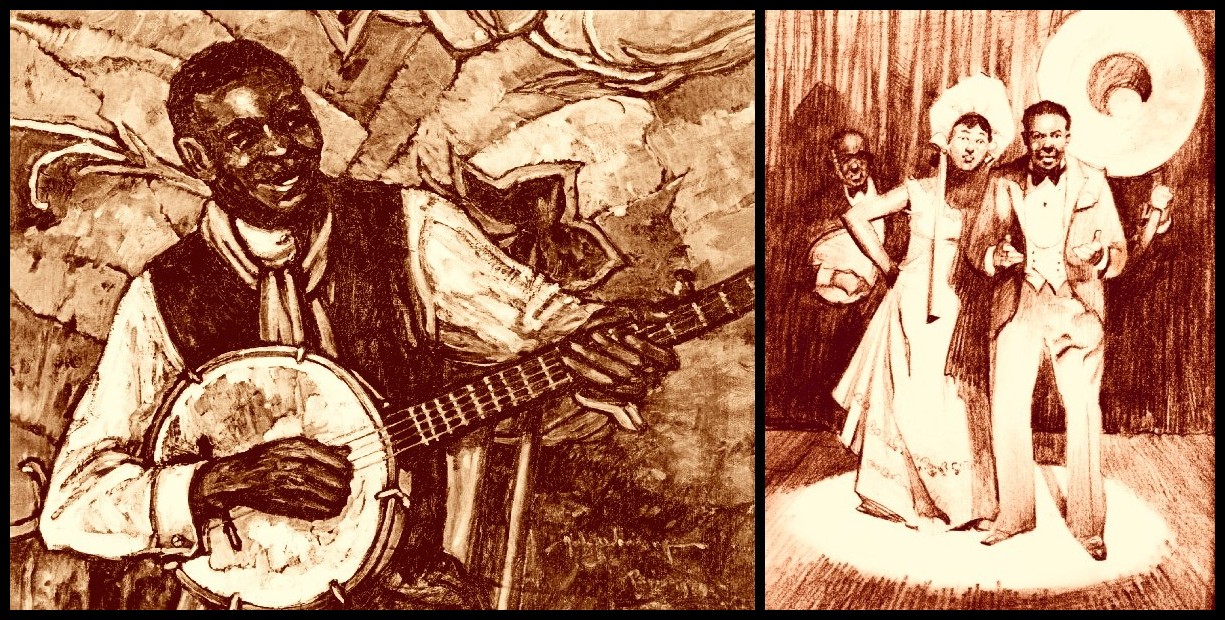
Hale A. Woodruff, Banjo Player, 1929 | Albert A. Smith, Cabaret, 1932
DEBUSSY – PRELUDES – BOOK II
1. BROUILLARDS
‘Brouillards’ is based entirely on the opposition between the white and the black keys, with the left hand’s illusory C-major being constantly opposed by the right hand’s aural fog. Pianist Alfred Cortot speaks of ‘a vapour of sonorities, suspended in the superposition, at the minor second, of tonalites that blend into each other’. In fact, there is a filling in of the aural space with the twelve tones of the chromatic scale, foreshadowing the tone clusters of contemporary music. That is but one aspect of the modernism of this piece, for its riches, lying beyond the scope of traditional Debussyan exegis, are more amenable to the techniques of contemporary music analysis. In this regard, German composer Dieter Schnebel (1930-2018) remarked: ‘No theme, no development; no traditional form; no counterpoint, but neither any harmony in the usual sense of the term; no melodies, no accompaniment; no principal and secondary voices; neither diatonic nor chromatic tonality—is there even a tonality? Nothing that echoes other composers—Schoenberg, Mahler—of the time. Instead, an aural chemistry, in which processes replace traditional structures’. Schnebel finally resorts to statistical compositional criteria, such as those used in Stockhausen’s Gruppen, but also, already, in Debussy’s Jeux. Finally, note the spatial dimension of the sound: in the rare moments when the fog dissipates, fragments of melodic lines appear in octaves in both hands, playing four octaves apart.
PERFORMANCE (E. Robert Schmitz, The Piano Works of Claude Debussy, pp. 163-64)
In the performance of this work, it is particularly necessary to remember again that Impressionism is not an apology for sloppy performance, inaccurate pedaling, and an indiscriminate fusion of sounds into an inarticulate mass lacking in any design or reason for existence. It is worth repeating that such works as ‘Brouillards,’ which is typical of a small group of more evanescent sketches, have brought a completely erroneous notion of their nature and of Impressionism in general by their model harmonic textures, the nature of their subject matters, and by a convenient inertia on the part of the performers. The balance of the multiple keys, of the superimposed materials, demands an even greater abnegation of the performer for the successful projection of such a prelude as this. A careful gauging of the relationship of the opening section, with the chords only slightly more in evidence than the opposing sonorities of the arpeggi, and the attention to the minute changes of dynamics for the more dissonant meetings of the contrasted levels are two of the main concerns of the performer in this work. They are best effected with a minimum of pedaling or else with a pedal frequently changed and depressed only to half-depth. Despite the relative rapidity of the thirty-second-notes, the technique used on them must be light but not crisp; the condition of the fingers then must not be vertical or forcibly flexed. The chords, also light, but allowing for somewhat more tone, may be slightly more prehended. At measures 29-30, note the dynamic apex built rapidly over the ascending arpeggi: the G natural in the right hand forms a dissonant element which helps to build the dynamic tension of the passage.
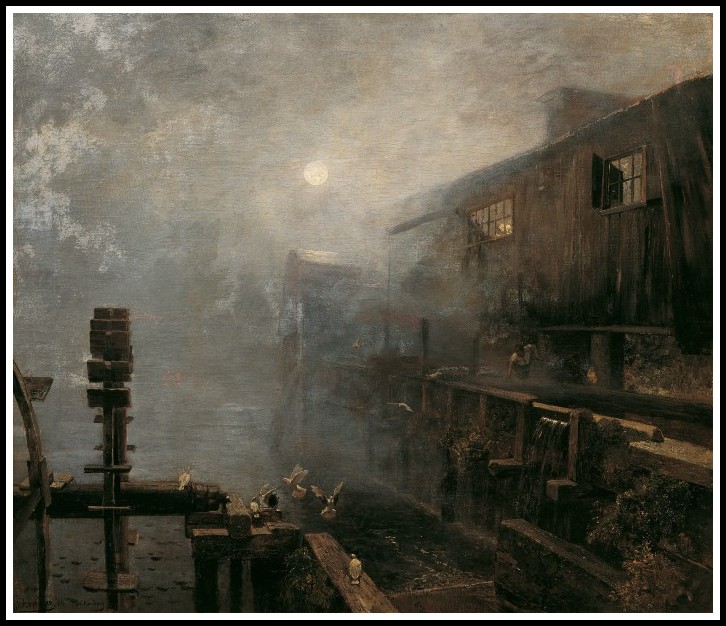
Emil Jakob Schindler, Sawmill in Morning Fog, 1886
2. FEUILLES MORTES
The delicate but firm structure of ‘Feuilles mortes’ (lent et mélancolique, C-sharp minor, 3/4) is endowed with harmonies of delicate and surpassing beauty, even more so than in Jeux. Everything here is based on the initial chords, typically Ravelian, of the root-augmented sixth and fifth. There is not a single non-harmonic tone that is not the distilled quintessence of a supremely concentrated harmonic thought, and yet the tonal structure is articulated around a rigorously classical ternary form, with a middle based on the dominant and sub-dominant of the principal tone. In contrast to the atonality of ‘Brouillards’, ‘Feuilles mortes’ is an example of an inordinately broadened tonality. The rhythmic subtlety contributes to the painful splendor of this haunting autumnal vision, this ‘sweet rot’, as pianist Marguerite Long puts it, through which Debussy has expressed his anguished dread of death, or simply of time passing.
PERFORMANCE (E. Robert Schmitz, The Piano Works of Claude Debussy, pp. 166)
The interpretation must seek a sustained legato in the opening section, with dynamics following the lines of the melodic curve. The tempo is frequently taken too fast in the softly melancholic opening, and therefore the middle section (‘un peu plus allant—a little faster’) loses its gravity in overreaching the first section. Less soft, the middle section affords a drier color for its opening bass, and its frame chords (measures 25-30); not to the point of staccato, but light within the subdued dynamic level of these accompaniment figures which must leave a clear field to the melodic elements for fuller expression. A still clearer color can be used for the ensuing section in which the rhythm, harmony, and Debussy’s markings achieve the climax of the prelude’s tension. Yet this climax is only mezzo-forte, and it must not break the structure by too loud a conception. A minimum of pedal, if any, is recommended for this section, which in contrast to the first is no longer soft and legato but sharp in its alternation of chords; therefore resonances must not blend.
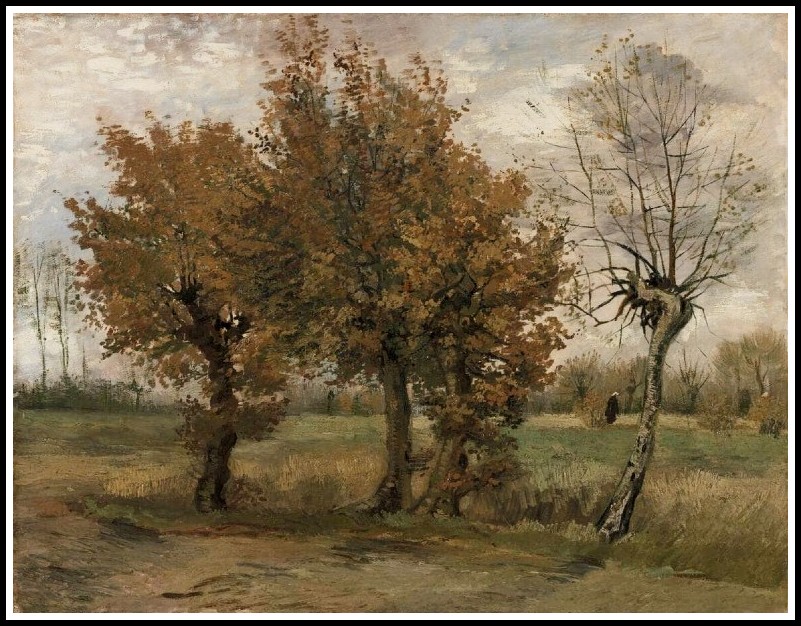
Van Gogh, Autumn Landscape, 1885
3. LA PUERTA DEL VINO
A simple postcard, sent by Manuel de Falla, inspired in Debussy this impassioned vision of the turbulent life of the piazza in front of the Alhambra. Falla recounts: ‘The photo represents the famous Alhambra monument. Decorated with colored reliefs and shaded by tall trees, the monument contrasts with the sun-drenched street visible through the arch’. It was this contrast of light and shade that struck Debussy; upon reception of the card, he said: ‘I’ll do something with this!’. This is not a genre scene, as some have said, with majas dancing in a low dive; rather, it is another leaf from Debussy’s book of solitude. Debussy wrote at the head of the piece: ‘With sudden oppositions of extreme violence and passionate softness’, and his hot and pungent sonorities—red ochre, burnt sienna, raw umber—set to an obsessive habanera rhythm drew from pianist Marguerite Long the following exclamation: ‘It sounds like aural tannic acid!’. Once again, audacities of musical language occur within a formal and tonal framework of a highly effective spareness: ternary structure, with the middle around the relative of B-flat minor, the principal tonality being D-flat. But the Gypsy mode chosen by Debussy—E with A-flat diminished fourth—establishes the most stretched harmonic relationship possible (seventh and tritone) with the D-flat root. La Puerta del Vino, the summit of ‘Spanish Debussy’, turns out to be much closer to García Lorca’s Andalucía than to the clichés of folklore.
PERFORMANCE (E. Robert Schmitz, The Piano Works of Claude Debussy, pp. 168-69)
Note first that the prélude is marked as ‘Mouvement de habanera’ (‘In the motion of the habanera’), not in the tempo of habanera. Like ‘Soirée dans Grenade’ this prélude is frequently played too fast, and too rigidly. All dances are characterized more by their rhythm than by their tempo. A waltz may be slow or fast and still remain a waltz. Similarly the habanera can vary in tempo, and within that tempo retain suppleness of line. Observe next that Debussy heads this prelude with ‘avec de brusques oppositions d’extrême violence et de passionnée douceur’ (‘with sudden oppositions of extreme violence and passionate softness’). This injunction is usually only half realized, the entire prelude being either uniformly languid or uniformly violent. One should then note the successive markings: F, P, PP, F, FF, MF, P, PP, etc., and further note that Debussy marks the wanted distinction between the various levels; for instance, in the fifth measure, where the bass is marked PP, and the upper part is marked P ‘très expressif.’ At the marking ‘ironique,’ it is suggested that the upper notes be held for their durations by the fingers, whereas the pedal catches only fleetingly the bass notes. Further, the note on the second beat can be slightly anticipated, and the last melodic note of the measure may be slightly lengthened.
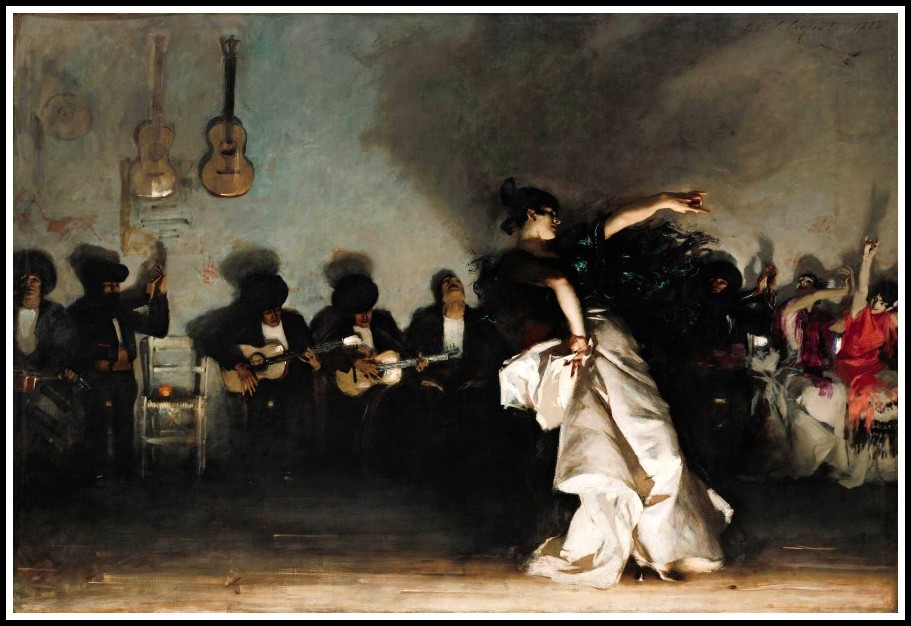
John Singer Sargent, El Jaleo, 1882
4. LES FÉES SONT D’EXQUISES DANSEUSES
This scherzo (rapide et léger, D-flat major, 3/8), marvelous in its delicacy, with rhythms and sonorities as elusive as the unreal beings they evoke, unfolds in a charmingly unsettled harmonic atmosphere: the bitonal opposition between the two hands, the right on the black keys, the left on the white. After the dance of these dream creatures, which pianist Marguerite Long called ‘the capricious daughters of the nymphs of L’Après-Midi d’un Faune’, we hear their song. The piece then concludes with a dreamy quotation of the horn in Weber’s Oberon, here a mysterious epilogue from the King of the Fairies, and not an active presence as in ‘La danse de Puck’.
PERFORMANCE (E. Robert Schmitz, The Piano Works of Claude Debussy, pp. 170-71)
The performance demands a very rapid and light finger action for the opening section. A more singing tone, lyric, rubato, is afforded for the contrasting sections (rubato, sans rigueur, caressant) in which dissonances and curves of the melodic line can be given minute attention in giving full expression to these sections. These sections can also afford the coloring of the pedal which is quite out of keeping in the opening section. The many forms of trills, some incorporated into the texture and others indicated by symbol, should be fluent and unmetric in their pulses.

Leonora Carrington, The Q Symphony, 2002
5. BRUYÈRES
‘Bruyères’ is a serene piece (calme, doucement expressif, A-flat major, 3/4). One imagines it resonating in the moors. Through its pentatonic structure typical of the Celts it echoes ‘La fille aux cheveux de lin’. The two preludes have the same calm, the same purity, the same diatonic transparency, as well as the same meter and tempo.
PERFORMANCE (E. Robert Schmitz, The Piano Works of Claude Debussy, pp. 171-72)
A structure similar to that found in a majority of the preludes is here again in evidence, and brings us a very charming contrast of tender, introspective improvisations with livelier cadenza-like passages, both so reminiscent of the timbre of the flute heard in the clarity and quiet of the early evening air, that the pianist is hard put to realize this tonal conception of his instrument. One observes first that dryness and staccato effects are herein nearly non-existent. Even the shortest note-values, performed exactly as to timing, are yet given a legato singing quality. Curves, and not angles, are of the nature of this composition, which means in effect that dynamic jerks or sudden outbursts are also to be eliminated. The use of the soft pedal will give the very desirable feeling of a faraway scene. Yet the abuse of an anemic or over-romantic boudoir lushness would fall in the other no less pernicious extreme, for the simplicity of this charming scene does not condone perverse effects. A plastic but naïve grace, capable in turn of joy, tenderness, nostalgia, yet subdues these emotions within the great calm of the whole.

Bruyères, Le cap de la Chèvre, Crozon-Bretagne – Photo: Jean-Marc Durou | Debussy
6. GENERAL LAVINE—ECCENTRIC
Debussy demanded a mechanical rigor in the performance of this piece, and insisted it must not be played too fast. Maintaining this rigor fosters an ironic exactitude of this burlesque pantomime, the end and death of the romantic humoresque, abruptly interrupted by the steely spring of a pirouette. The sonorities of the piano evoke, with great precision, those of a jazz band: after the strident trumpet calls that open the piece, we can easily imagine the ‘witty and discreet’ dance melody played on the double bass or baritone saxophone. Note that F-major, for Debussy a comical tonality, is also found in ‘Hommage à S. Pickwick’.
PERFORMANCE (E. Robert Schmitz, The Piano Works of Claude Debussy, pp. 174-75)
In the performance observe first that the thirty-second-notes of motif A-1 must be rapid and very sharp (strident), whereas the A-2 motif, though dry, is more at ease, phlegmatic in its trend, with the exception of the SFF measure 7. The second subject is good-humored, discreet, easy-going, but is frequently jolted by the motif A-1, or by chromatic sequences. This alternation of dry, staccato, loud accents, with softly laconic passages is of utmost importance to the humor of this clown, full of tricks, surprises, sudden turnabouts from a poker face to exaggerated expressions of surprise, pain, laughter. It is baroque music, enjoying fully these extreme oppositions of dynamism, and the performance must not underrate their effects.
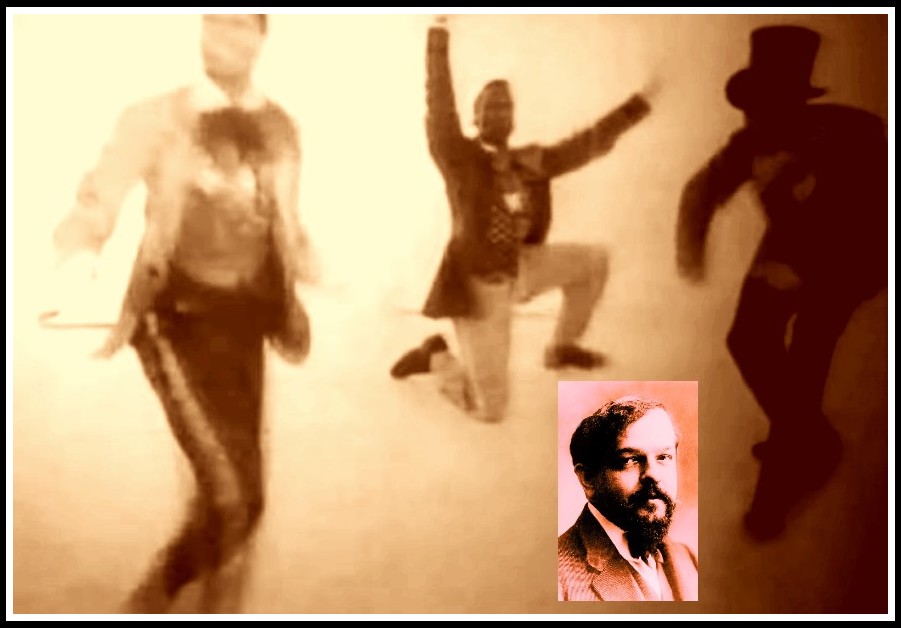
Cake Walk | Debussy
7. LA TERRASSE DES AUDIENCES DU CLAIR DE LUNE
‘La terrasse des audiences du clair de lune’ offers a vision of a dream India, but in contrast to the pentatonic ‘Pagodes’ from Estampes, it bears no trace of a literal exocticism. Yet the piece, in its milky clarity of F-sharp major (lent, 6/8) and its muted underlying tension maintained by the tritone C-sharp—G, is indeed Oriental. (It is, if one likes, a richer, more ‘ripened’ counterpart to ‘Les sons et les parfums tournent dans l’air du soir’ of Book I.) The beginning evokes, with gentle irony, the first notes of ‘Au clair de la lune’, poeticized by the delicate harmonization in sevenths. Then, via a musical language of great freedom and subtlety, Debussy delivers the most magical of his nocturnes. We hear for a moment the theme superimposed on its inversion, then the rest lights up brightly (dominant of C-major, ‘opposite’ of F-sharp), before the recapitulation, inverted and subtly varied in myriad ways, takes us back to the very cold and ‘lunar’ final, suspended chord.
PERFORMANCE (E. Robert Schmitz, The Piano Works of Claude Debussy. Dover Publications, Kindle Edition, pp. 177-78)
The two levels of action at the opening are marked by Debussy in such a way as to give dynamic preference to the lower level, and subduing the upper arabesque which, at PPP, should be a bare whisper. The notation ‘un peu en dehors’ (somewhat brought out) is certainly in view of preserving this important motif from becoming mere accompaniment to the arabesque. As to tempo, observe that, at the opening of the large middle section, one returns to ‘au Mouvt.’; the return is obviously to the slow tempo of the opening, since the only change since has been for slightly more animated, three bars before the middle section. There are two fragments which are accelerando in this section, i.e., measures 20-24 and 28-31. The remainder is in the tempo of the beginning. In the last section, the seven measures of the end are slower than the opening tempo. It will be noticed that the measures of six counts are not metrically identical; they fluctuate readily between measures of two plus two plus two, or measures of three plus three, or measures of six equalized beats. One of the interesting and challenging effects is given in the third measure and in many later portions, i.e., the Viennese waltz, which divides the measure in two bars of three beats with a strong first beat, a swell to the third beat which is somewhat elongated or suspended in the air. The swell indicated by Debussy is an orchestral effect difficult even to approximate at the piano. The low pedal (C in this measure) can be of some help in heightening the dynamics in transit to the third beat. In measure 30 the lower accent to the second beat of the measure realizes even better this effect of swelling, or fast crescendo. It should be obvious that the romantic character of the middle portion would demand an expressive, singing tone, an interpretation lavish in its observance of the curves of the melodic line and the rich dissonances, appoggiaturas, and sensitive harmonies, yet keeping the proportions within the scope of this thoughtful sketch, which never quite forgets its opening mood.
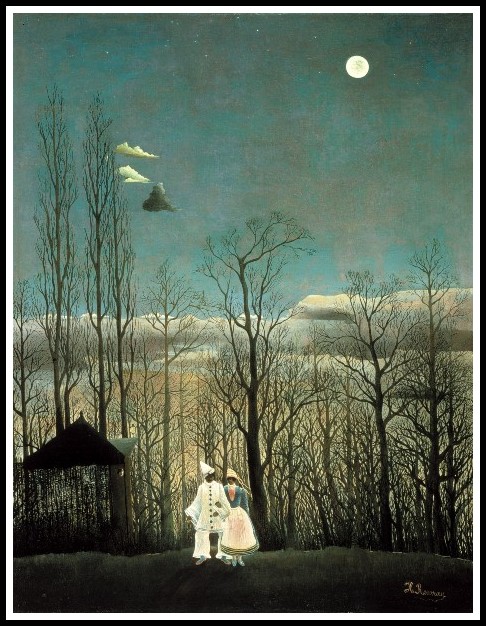
Henri Rousseau, Carnival Evening, 1886
8. ONDINE
This neglected sister (scherzando, D major, 6/8) of Ravel’s ‘Ondine’ is a mischievous nymph—shimmering, naked, seductive—gallivanting in the waves before attempting to beguile a human being (E-flat pedal). She then dreams languidly on the sand, regretting she is not mortal—the melancholy middle theme and its dissonant seconds—then, after a dominant pedal whose harshness expresses her disgust, she disappears in a pirouette, transformed into sea-foam. The performer must keep this ending very clean, with this brief backwash masking the retreat of the vanishing nymph. Every virtuosic feature in ‘Ondine’ is part and parcel of the musical substance. The hexatonic scale E-flat F-sharp G A B-flat D-flat falls insidiously easily into the tonal context of D-major.
PERFORMANCE (E. Robert Schmitz, The Piano Works of Claude Debussy, pp. 179-180)
In the performance of the opening section, and the last also, one must be aware that the many motifs fall into two types; one evoking the opalescence of underwater, and the others the scintillating surface effects. The dynamics will be softer for the first group, sharper for the second, and will also determine the touch, which will alternate between a singing tone, born of flexible, relaxed fingers, and a crisper tone, born of curved finger action, but not heavy in dynamism. Measures 11-13 are excellent illustrations of the rapid interplay of these two types of material, the notes in small type demanding the crisp rapidity, whereas those in heavy type are more singing, softer. The second section brings the performer the problem of the minute slurs by two of the melody, which, however, must not detract from the scherzando lightness of the passage. Observe in the C section the staccato bass, the long legato middle pedals, and the melody, part staccato, part legato. These oppositions are very important. In a number of sections the bass pedal tones should be sensitized by the sustaining pedal. Note the climaxes on the apexes of the melodic lines: a swelling wave motion of the opening section, expressive and suggestive in its orchestral colors, so apt to such effects.
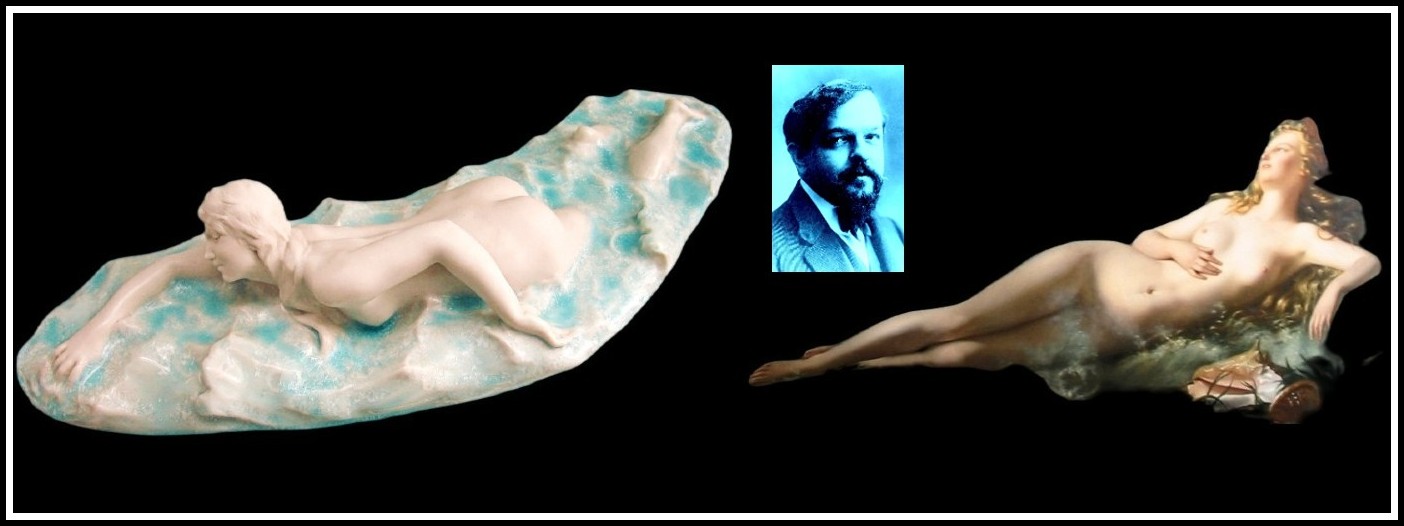
Paul Massoule, Ondine, 1906 | Adrienne Duport, Ondine, 1881 | Debussy
9. HOMMAGE À SAMUEL PICKWICK ESQ. P.P.M.P.C.
Debussy gently mocks Dickens’ likeable hero, who appropriately enters the scene to the strains of ‘God Save the King’(grave, F major, 3/4). At the call of the horn, his rickety jalopy sets off down the road. The alternation of timidity, absent-mindedness, and self-satisfaction portray the character and render the caustic affability of the sketch. The piece, with its timbres evoking the orchestra, is highly colored: an example of Debussy’s wry sense of humor.
PERFORMANCE (E. Robert Schmitz, The Piano Works of Claude Debussy, pp. 181)
It is obvious that the best performance of this piece depends on the amount of humor one sees in it. A letter-correct performance, but not imbued with the spirit of fun could be well-nigh deadly. All those violent contrasts must be realized, given their proper character; their timing is of the art of good story-telling. A heavy, sluggish accentuation of the dotted rhythm theme robs it of all its character, and takes away the humor of its querulous crescendi. Similarly, a light and charming interpretation of the opening section would be treachery indeed. One must also watch for the more expressive melodies superimposed above or below the dotted rhythms and which must be placed on a different interpretative level. In the third page the thirty-second-note runs must continue without interruption, to land on the longer note value on the upper staff; an effect of ‘hiccups’ in cutting these runs off from their landing place may be humorous, but is not indicated by Debussy. The whistled air, very light, distant, scherzando.
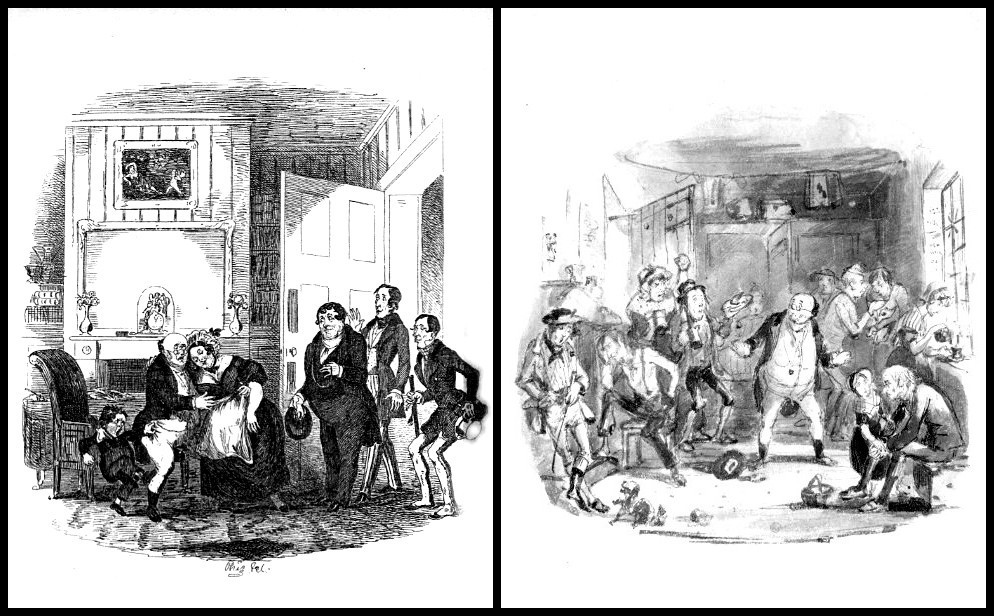
Phiz, The Pickwick Papers, 1837
10. CANOPE
‘Canope’, one of Debussy’s most mysterious and enigmatic pieces, is also one of his most modern and prophetic. The parallel perfect chords at its inception (très calme et doucement triste, D minor, 4/4) remind one of the beginning of Le Martyre de saint Sébastien, as does, later, the hired mourners’ chromatic and Orientalist modal lament. The entire piece unfolds in a hieratic, strangely distant atmosphere, engendering a sensation of infinite solitude that is reinforced by an ending that is not an ending: we remain suspended in the void, stared down by the head of Osiris that seals the Canopic jar. Once again, Debussy has fused space and time.
PERFORMANCE (E. Robert Schmitz, The Piano Works of Claude Debussy, p. 183)
The calm legato and the phrasing marked by Debussy seem the two most important factors to recommend to the performer in the opening material. In the ensuing two motifs the minute differentiation, within the ‘piano’ dynamic level, of the notes marked with a dash, accented and held, while those marked by a dot are lightly detached, and those that are slurred and legato, joined together, are the most important in these short but highly expressive materials. Note that the A at the beginning of measure 7 is the end of the preceding phrase and should not be detached from it. The final chord, a pedal of superimposed fifths (C-G-D), does not assuage our thirst for a final cadence. We are left with a choice of three tonal centers, and yet none.
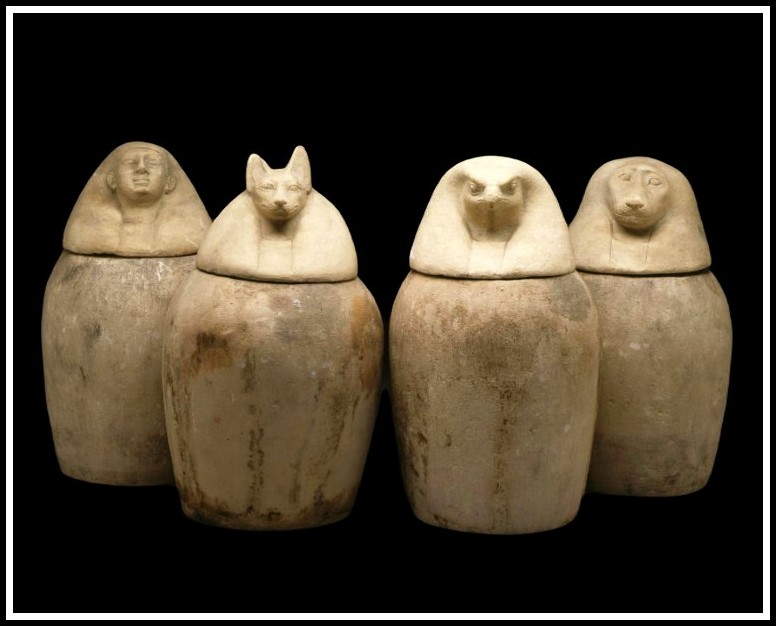
Set of Canopic Jars, Late Period – 26th Dynasty, 664-525 BC | Penn Museum
SIGLIND BRUHN ON ‘CANOPE’ – DEBUSSY – PRELUDES II – 10
Posted by kind permission of Siglind Bruhn, musicologist, concert pianist & interdisciplinary scholar
From Siglund Bruhn, Images and Ideas in Modern French Piano Music: The Extra-musical Subtext in Piano Works by Ravel, Debussy, Messiaen (NY: Pendragon Press, 1997) pp. 8-11
The caption of this prelude, and the nature of its reference to the musical content, are often regarded as a riddle. A ‘canope’ is an Etruscan burial urn, typically one with a lid bearing a likeness of the head of Osiris, the ancient Egyptian God ruling over the realm of the dead. Debussy is known to have had two such urns on his writing desk. The connotations are thus threefold: first, a vase—a solid object very unlike the waters and weathers, dances and moods, fairies and pixies whose lightness and ambiguity the composer usually favors; second, times long past—the Egyptian period with its worship of Osiris dates back to the third millennium B.C., and the Etruscan period is dated to the 9th or 8th centuries B.C.; finally, a solemn occasion, a funeral.
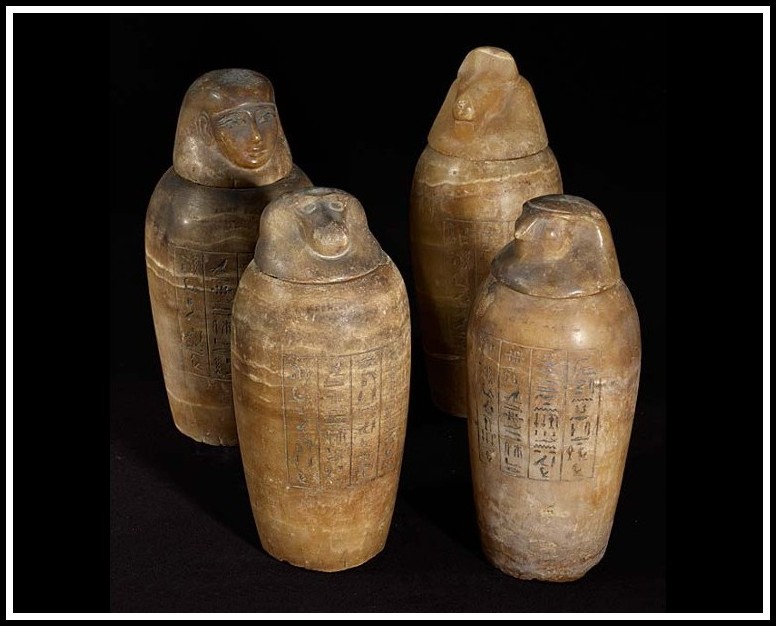
Four canopic jars of Horemsaf, circa 1069-1030 BC | Musée du Louvre
The indications for tempo and mood confirm this notion: Debussy requests très calme et doucement triste (very calm and softly sad). The opening theme (bars 1-4d, extended up to the downbeat of bar 7) may be perceived as depicting the slow pace of an ancient funeral procession.
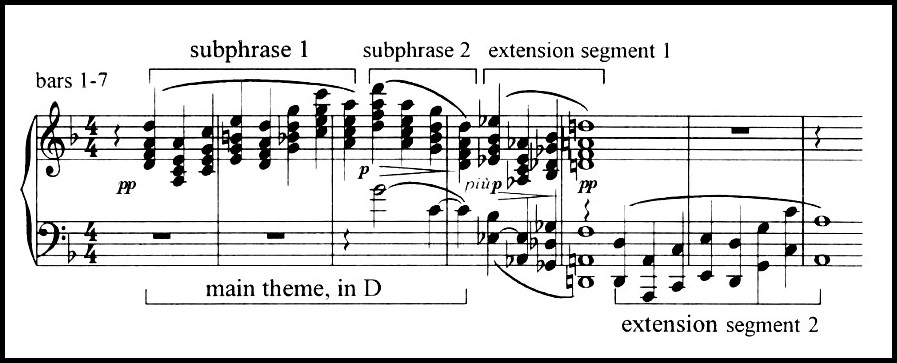
Debussy, Preludes II, ‘Canope’
The tonality in the main phrase fluctuates, owing to the B-natural/B-flat alternation, between the minor and the Dorian scales on D. The melody, while in itself pentatonic (employing only the pitches D E G A C), clearly confirms D as the tonal root: it begins and ends on D, while its first subphrase also emphasizes A. All melodic notes except for the C are supported by minor-mode triads, thus giving this phrase a very unified mood—were it not for the middle-strand notes which, accompanying the shorter second subphrase (bar 3), throw a light of doubt on the simple tonality.
The extension consists of two segments. The four chords in bar 4-5d convey three impressions simultaneously:
– they continue the solemn pace and conclude in a D-minor chord, thus confirming both the ceremonious occasion and the tonality;
– they temporarily slow down the tempo (cedez – – – // mouvement = give way up to the sign //, then resume the previous tempo), thus underscoring the basic mood;
– their three consecutive major-mode chords contrast with the use of minor-mode triads prevailing so far, thus striking a different emotional string, one that is often perceived as more direct, warmer and thereby more touching.
The second extension, while retaining the rhythmic pace and returning to the original tempo, differs in texture—it presents a unison melody under the sustained D-minor chord. Its melody is an exact recurrence of the theme’s first subphrase.
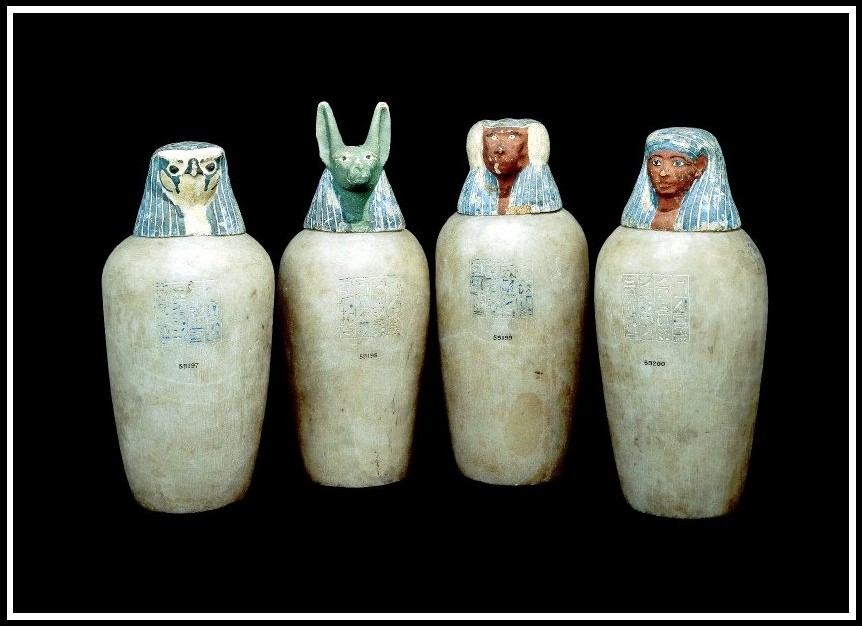
Canopic jars of Neskhons, 21st Dynasty | The British Museum
The following four bars can be imagined as a kind of religious chant, first sung by the priest alone (bars 7/8) and repeated by the congregation (see the doubling in octaves in bars 9/10). Both utterances are accompanied by protracted D-major seventh chords.

Debussy, Preludes II, ‘Canope’
A subtle effect of bitonality is created here. While the downbeat A, enhanced both by its separate entrance before the remainder of the chord and by the dash and subsequent p—pp hush, clearly serves as the fifth in a D-major harmony, it also provides the root for an A major triad whose third and fifth (see the C-sharp in its prominent position at the beginning of the chant’s two lines and the E-natural, additionally emphasized with an acciaccatura, at the first climax) are filled with mournful chromatic steps.
In the following phrase, the lamenting becomes increasingly poignant. The melodic rhythm appears more impassioned; the harmony is less poised and, with changes in every bar, more high-strung than before. Even the phrase structure reflects the state of heightened urgency with its significant elision (the D in bar 14 is both the final note of a phrase—compare the melodies in bars 11/12 and 13/ 14—and the beginning of the new development in bars 14/15).

Debussy, Preludes II, ‘Canope’
The central segment of the prelude, while still in soft hues, conveys a sense of agitation. Bars 14/15 simultaneously embody three tonal areas: D minor in the melodic treble and E-flat major in the middle-strand counterpoint sound before C-F as a harmonic backdrop. The B-flat major / G minor of bars 17 and 19 seems to answer the call of the harmonic strand, but the resolution into an enharmonically notated A9 (bar 18) thwarts any sense of an even momentary tonal commitment.
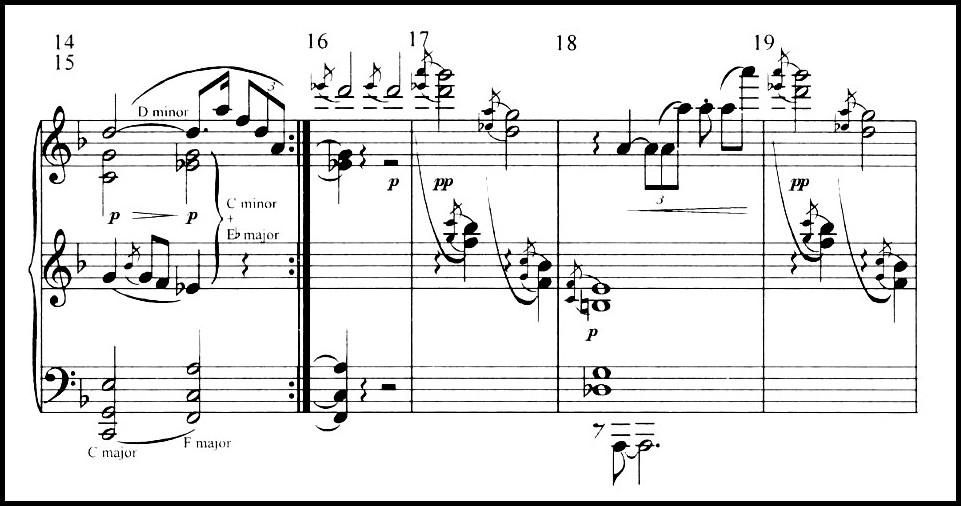
Debussy, Preludes II, ‘Canope’
In a slightly increased tempo (animez un peu), the triplet patterns on A recall the rhythmic pattern of the chant. The actual chant recurs in bars 20/21 and 22/23, albeit over a new bitonal pillar that includes a G7 chord besides the A-major triad.
The subsequent tonal shift, from A major to an implicit A-flat major (bars 24/25), is conspicuous for the unusual symmetric pitch arrangement in the descending run. In an invention worthy of Scriabin and Messiaen’s artificial scales, Debussy devises a highly idiosyncratic combination of steps which, with 1/2 + 1 /2, 3/2 + 1/2 + 3/2, 1/2 + 1/2, is perfectly mirror-symmetrical, but does not confirm the underlying A-flat major tonality.
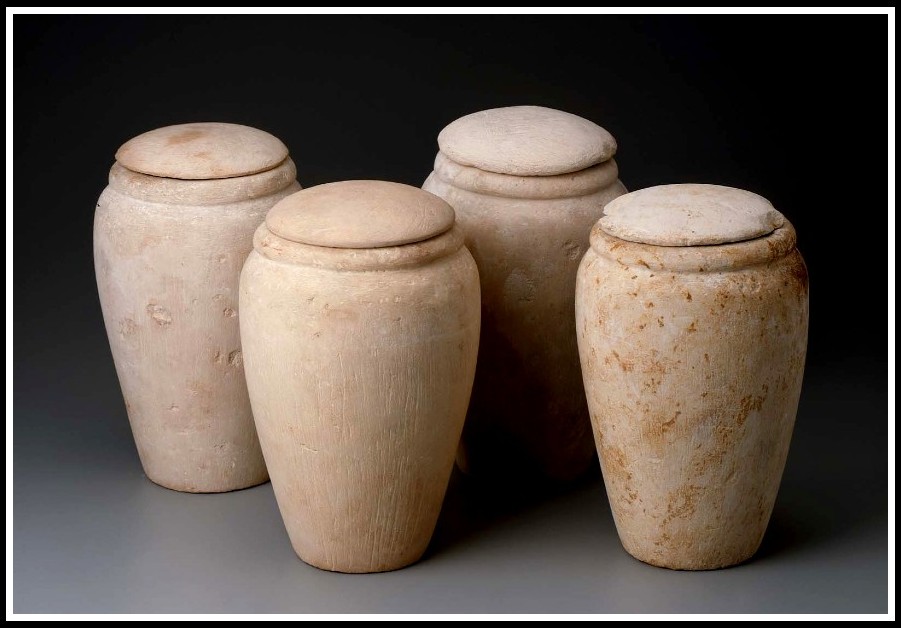
Set of canopic jars | Old Kingdom, Dynasty 5, 2465–2323 BC | Museum of Fine Arts, Boston
The evocation of an ancient funeral ceremony is completed by a recapitulation of several components. The procession theme is heard once again with an identical first subphrase, reinforced with parallels in the left hand (bars 26-28d). Its second subphrase is transposed up one semitone and thus abandons the relationship to D as a tonic (bars 28-29d). The first extension also begins in semitone transposition but then deviates even more and concludes, harmonically ambiguous, on the chord that supported the most agitated phrase (compare the chord in bars 30-33 with that in bar 14d and 15d). The treble recalls the lament in its original pitch pattern (compare upper strand bars 30-31 with bars 11-12). The tempo slows down more and more (from retenu = held back in bar 29 via plus lent slower in bar 30 to très lent = very slow in bar 32). Correspondingly, the intensity decreases from the earlier pp through très doux et très expressif (very soft and very expressive) to encore plus doux ( even softer).
To complete the impression of sounds of mourning retreating, the melody omits its final note, the very clearly anticipated D, and the work thus closes as if hanging in the air, in deep absorption.
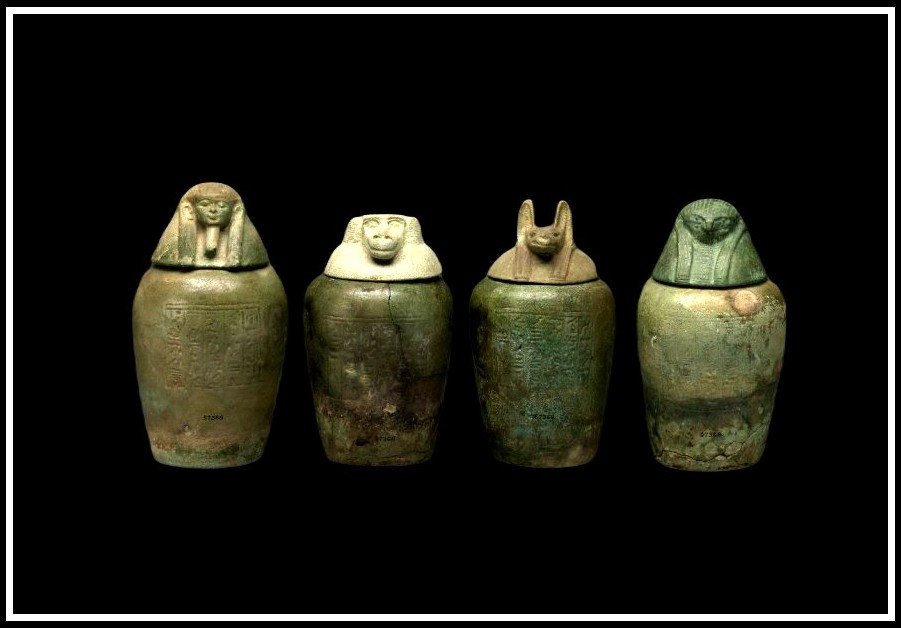
Set of canopic jars of Psamtek, 30th Dynasty | The British Museum
SIGLIND BRUHN: TWO BOOKS
CLICK OR TAP ON THE IMAGE TO GO TO A DESCRIPTION OF THE BOOK
‘CANOPE’ – PRÉLUDES II – DEBUSSY – IN ‘MARA, MARIETTA’
FROM ‘MARA, MARIETTA’
Part Nine Chapter 7
̶ Now lie back and listen to this.
I lie back and close my eyes.
Slow, quiet, contemplative, the chords come, unfolding a percussive melody veiled in an infinity of vibrations. So this is the place she is taking me to, the overtones at the edge of awareness; the place where, unbeknownst to us, we were destined to meet. What is she telling me? That friendship between a man and a woman is characterized by sublimation, and therefore is necessarily an ethical relation? That the feminine horizon where she and Marietta lie will always be ever-receding to me? That even in marriage, fluidity cannot be confined? Conjuring subtle sonorities, she explores the resonance of dying sounds. What is she telling me? That the appropriation and exclusion that characterize a sexual relation need not deprive the friend of intimacy? That friendship between lover, ex and beloved can be full of subtle harmonics that promise a new music? Listen how they come, as if from a distance, the resonances that give birth to melody; listen to the beauty of the sound. Gathering the silence into a slow arabesque, a rhythmless motion where love resides, Ingrid gathers in my thoughts. Not stating harmonic resolution but letting the overtone imply it, with meticulous control of touch and pedal she sounds a note—soft, softer, dying…
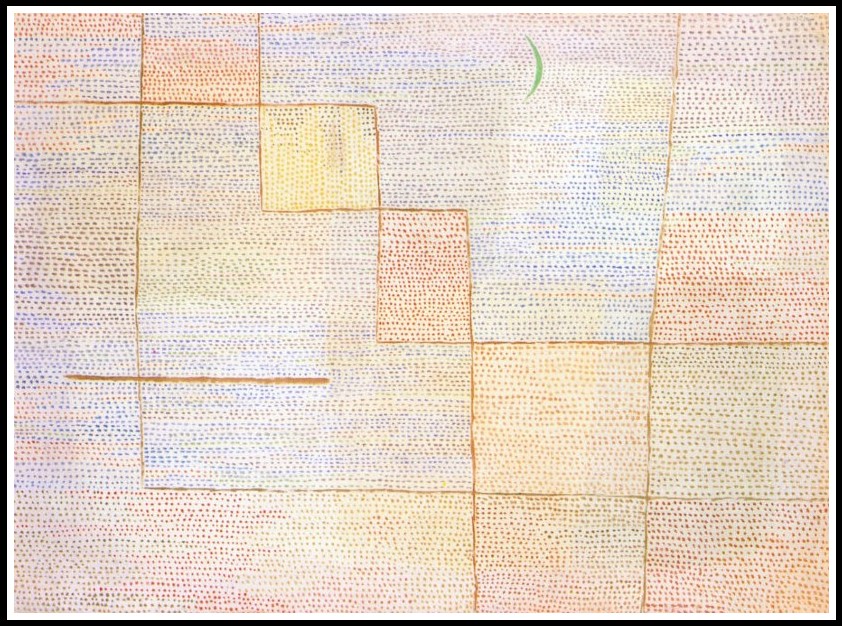
Paul Klee, Clarification, 1932
̶ Ingrid, you’re amazing! What depth in so few notes!
She smiles. We rise and return to the sofa.
̶ What was it?
̶ Debussy. ‘Canope’. From the second book of Preludes.
̶ It’s very moving, that immobility.
̶ The kind of paradox I like! Yes. It’s masterfully written. All harmonics and voicing.
̶ Have you recorded the Preludes?
̶ I haven’t. I enjoy playing them, I’ve got them firmly in my fingers, but I feel no need to record them.
The porcelain glow of her skin brightens in the lamplight; from pale blue to ash grey her eyes veer as she turns to face me more fully: I’d never have imagined otherworldly pallor could be so beautiful.
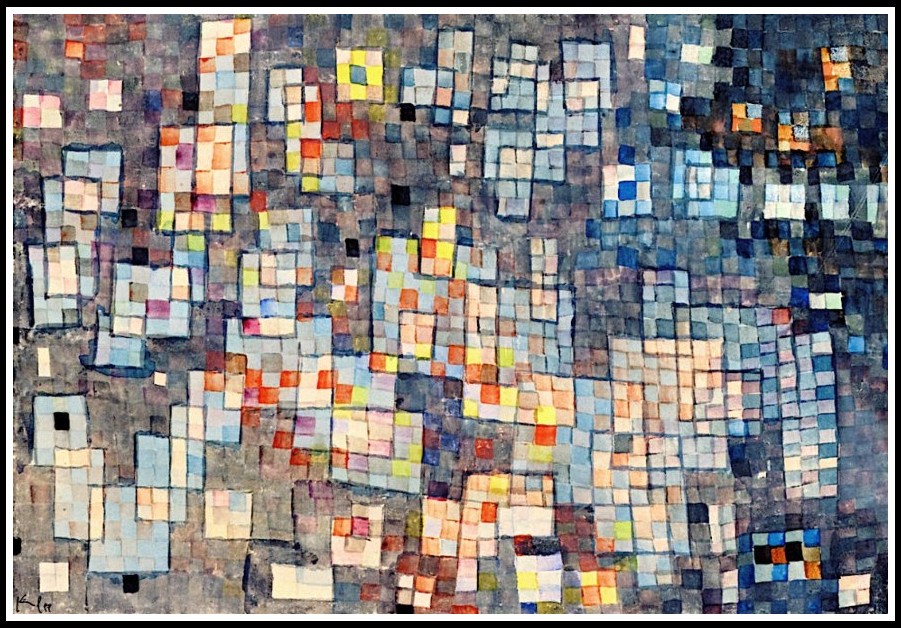
Paul Klee, Glashäuser Viertel, 1927
MARA, MARIETTA: A LOVE STORY IN 77 BEDROOMS – READ THE FIRST CHAPTER
A literary novel by Richard Jonathan
Richard Jonathan, Mara, Marietta: A Love Story in 77 Bedrooms – Read the first chapter
AMAZON & APPLE BOOKS
Richard Jonathan, Mara, Marietta: A Love Story in 77 Bedrooms | Amazon paperback or Kindle
Richard Jonathan, Mara, Marietta: A Love Story in 77 Bedrooms | Apple iBook
MARA, MARIETTA: A LOVE STORY IN 77 BEDROOMS
A literary novel by Richard Jonathan
11. ALTERNATING THIRDS
‘Alternating Thirds’ is not a prelude but an étude, a predecessor of the twelve études in the 1915 collection, and much more rigorous than any of them in its adherence to its technical pretext. After a few introductory chords (modérément animé), the piece unfolds as a perpetual movement in sixteenth notes (semiquavers) (un peu plus animé, légèrement détaché, sans sécheresse, C major, 2/4), sometimes with vaguely Spanish inflections, interrupted only in the middle by a brief development of the initial bars. Except for this middle, and the beginning from which it derives, the range is limited to a single octave, with the alternation of the black and the white keys frequently creating bitonal effects. With this revival of harpsichord technique—‘Alternating Thirds’ could be a Couperin piece—Debussy once again exalts static turning, self-consumption in one’s own whirling.
PERFORMANCE (E. Robert Schmitz, The Piano Works of Claude Debussy, pp. 185-86)
For the dynamics of the performance one is concerned with several elements: the large dynamic levels of the phrases, of which the evolution of the pedal-points is a good barometer, the harmonic rhythm of the progressions, and the melodic contour as to pitch and rhythm of the melodic notes. As to tempo, moderately animated at the beginning and a little more animated after the introduction, which does not mean a sudden headlong rush, full of acceleration and ritardando. The tempo remains even, the dynamics fluctuate. The middle portion by its note values makes a welcome contrast, but there is no reason to assume a slower basic tempo except at the word ‘retenu,’ a slight holding back, after which the original tempo is reinstated at ‘au Mouvt.,’ with no lapse to the end. No rubato is permissible in this prelude, and one of the greatest charms is the exactness of rhythm and tempo which follows through to its last soft notes. Even a cursory glance at the texture of the prelude should warn the performer that pedaling should be used only as a restrained coloring. In the introduction and the middle section, the texture is more adaptable to normal pedaling. The evolution of the materials in slower motion will be equally so, and in the other sections a better effect will be obtained through very reduced pedaling, and only in the crescendi marked by Debussy. It is suggested that the hand concerned with the moving thirds be placed over the hand playing the pedal-like thirds. It gives a slightly greater prominence to the moving material, and a greater clearance for motion to the hand which is under, which should have a lowered metacarpal bridge. Despite this slight dynamic advantage granted the moving voice, it must be remembered that both hands are limited by the markings of Debussy, ‘lightly detached but without dryness’. A crisp, crackling touch is not welcomed in this prelude. The motions of lift must be gentle and the fingers pliable in their muscular condition. This absorbency of the fingers becomes even more marked in the softly legato middle section.
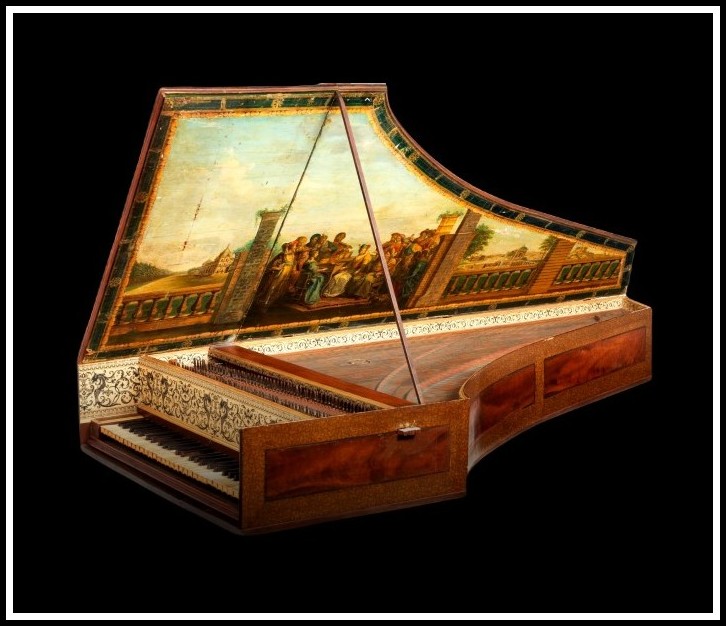
The Andreas Ruckers Harpsichord, 1646 | Museum Vleeshuis
12. FEUX D’ARTIFICE
Brilliant and poetic, ‘Feux d’artifice’, the most developed piece of Book II, concludes the Preludes with bouquets of light. Already in the score, the graphic look is Lisztian, with chains of arpeggios, cadences and—rare for Debussy—octave runs. Athematic, atonal and static, ‘Feux d’artifice’ is one of Debussy’s most audaciously innovative pieces. Its quasi-informal structure is not derived from any tonal unity.
PERFORMANCE (E. Robert Schmitz, The Piano Works of Claude Debussy, pp. 189-191)
In the performance of this work one is faced with a most taxing technical feat, for if this work concludes the Préludes, it also foreshadows the ‘Études’ in its demands upon the performer. A new phase of piano virtuosity is entered upon. The harmonic basis already demands of the performer a ready adaptability to rapid changes of level between patterns on black keys and on white keys, which in their interpretation must of necessity command an equal touch and kinesiological condition of the fingers and arm technique employed but transposed rapidly in levels. Further, observe that the rapid changes of dynamics over the long ascending line of this most exciting piece require control. So many performances of this work become a headlong, overfast dash for the finish, in which the piece becomes a jumble of sounds. All effects of sudden, strident accents contrasted to whirring crescendo softness are lost. The clear outlines of the main theme are lost in the various designs, which themselves take on the aspect of heavily amalgamated chords. The tempo is marked ‘modérément animé’, and within this tempo the clarity of texture will actually give a greater sense of speed than will a performance of the work at presto tempo, in which nothing can be heard. A judicious use of pedal is also of importance. For instance, in the opening passage no pedal, or a very shallow one, is best, as it is also in the transitional passage in clusters, bottom of third page. In the sections dealing with the theme, pedal may be used to good effect, but must not slur together its succeeding tonalities. Observe that election of dynamic levels must take into account the marked differences Debussy entrusts to the theme (‘très en dehors’) F, etc., and to the arabesques which follow the thematic coloring but always a shade under in dynamics. It is another illustration that the care with which Debussy selects his materials and fits them together allows for no romantic nonsense: there is not much leeway for ‘personal’ performances of Debussy.
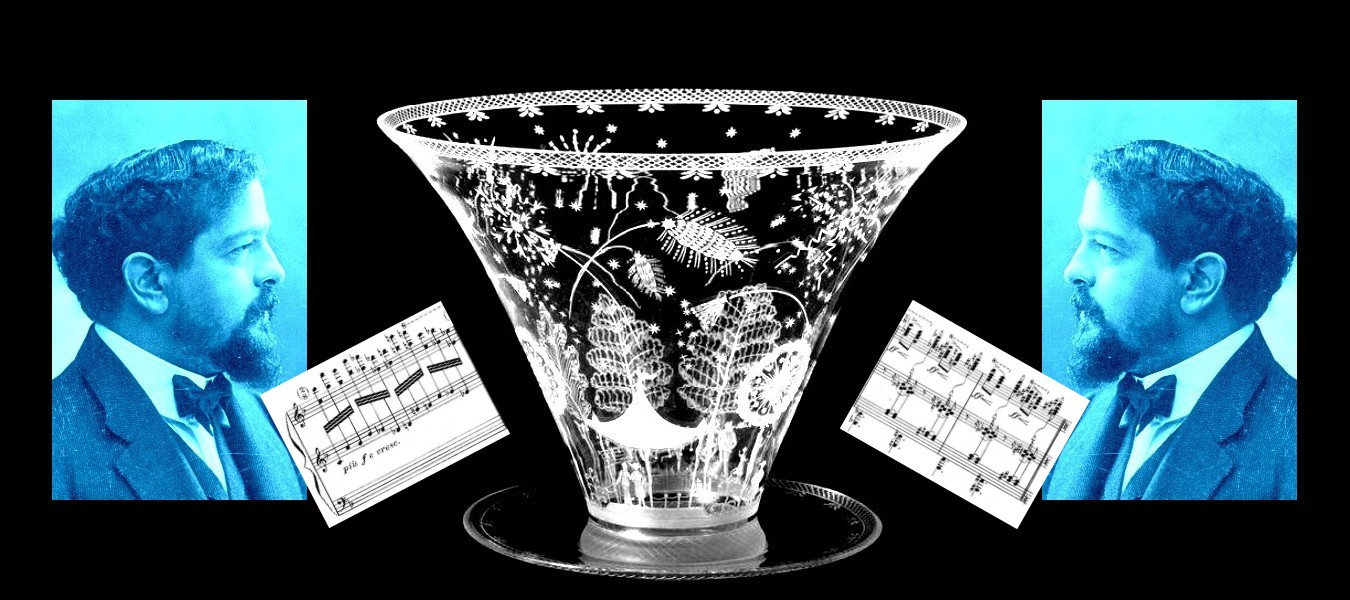
Edward Hald, Fireworks Bowl, 1930 | Debussy
